The Original Plan
We didn’t want to spend a lot of money on basement flooring, so we knew we wanted to keep things simple, especially since we weren’t going for a high-end look for the space. The basement is mostly unfinished, at least by traditional standards. We use the space mainly for working out, reading, office work, some smaller arts and crafts projects, and we’ve created a few small areas for miscellaneous storage.
Whatever we came up with had to be durable, if only to avoid having to replace any flooring should the basement ever have a problem with water (e.g. from a failed sump pump or a leaky hot water tank).
The plan initially was to just seal the floor with tung oil, much like we did for our wood floors. I thought if I used a slurry mix to patch some surface imperfections in the concrete beforehand that it might produce a pleasant mottled look across the entire floor once it was finished with the tung oil.
Unfortunately, once this patching was done, it quickly became apparent that the look was just messy, if not just boring and forgettable. Even tinting the slurry mix to various shades of blue and green didn’t seem to help at all.
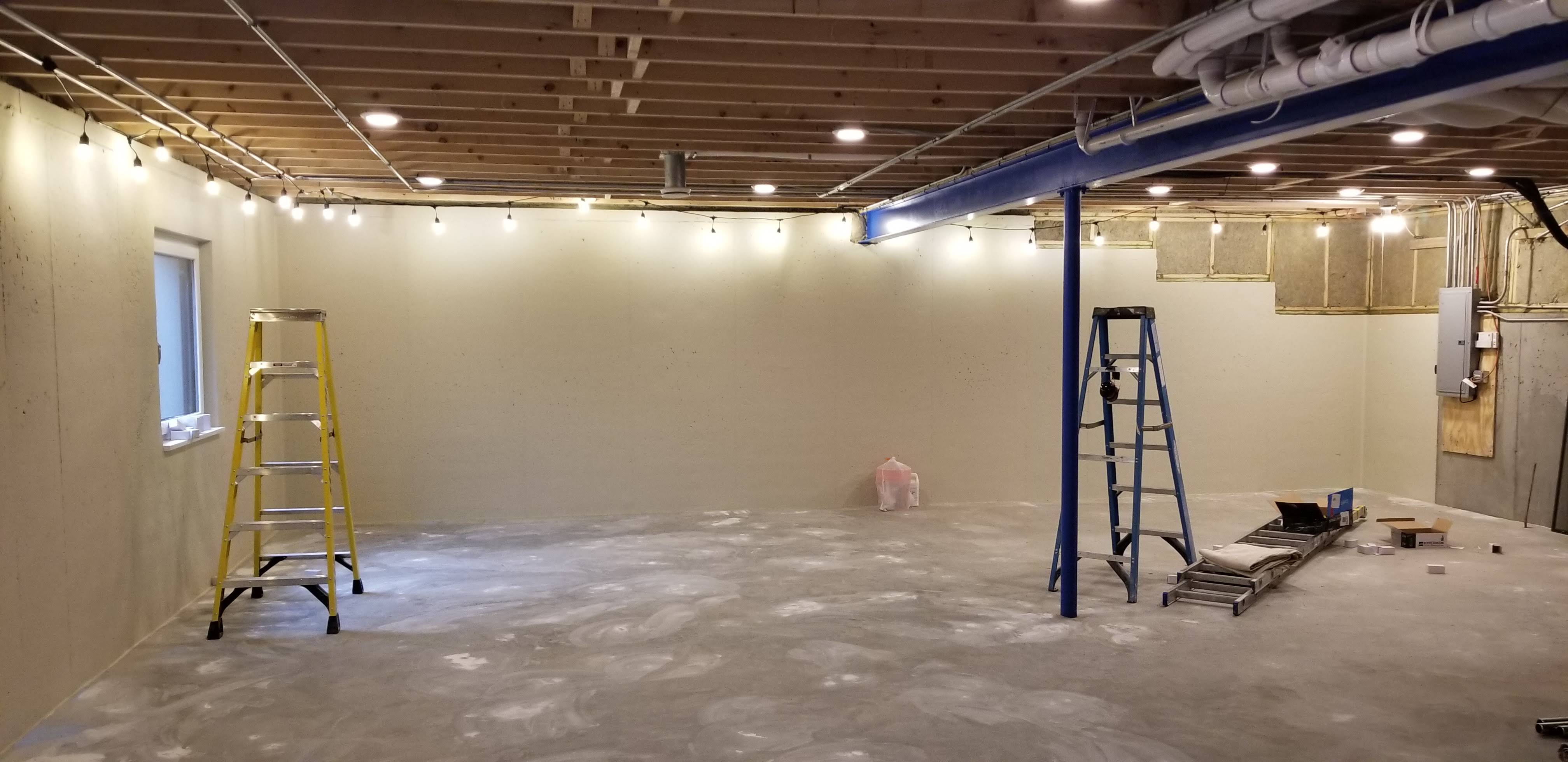
With the patching complete, I went ahead and did the tung oil application just to get rid of the constant concrete dust on the surface of the basement floor.
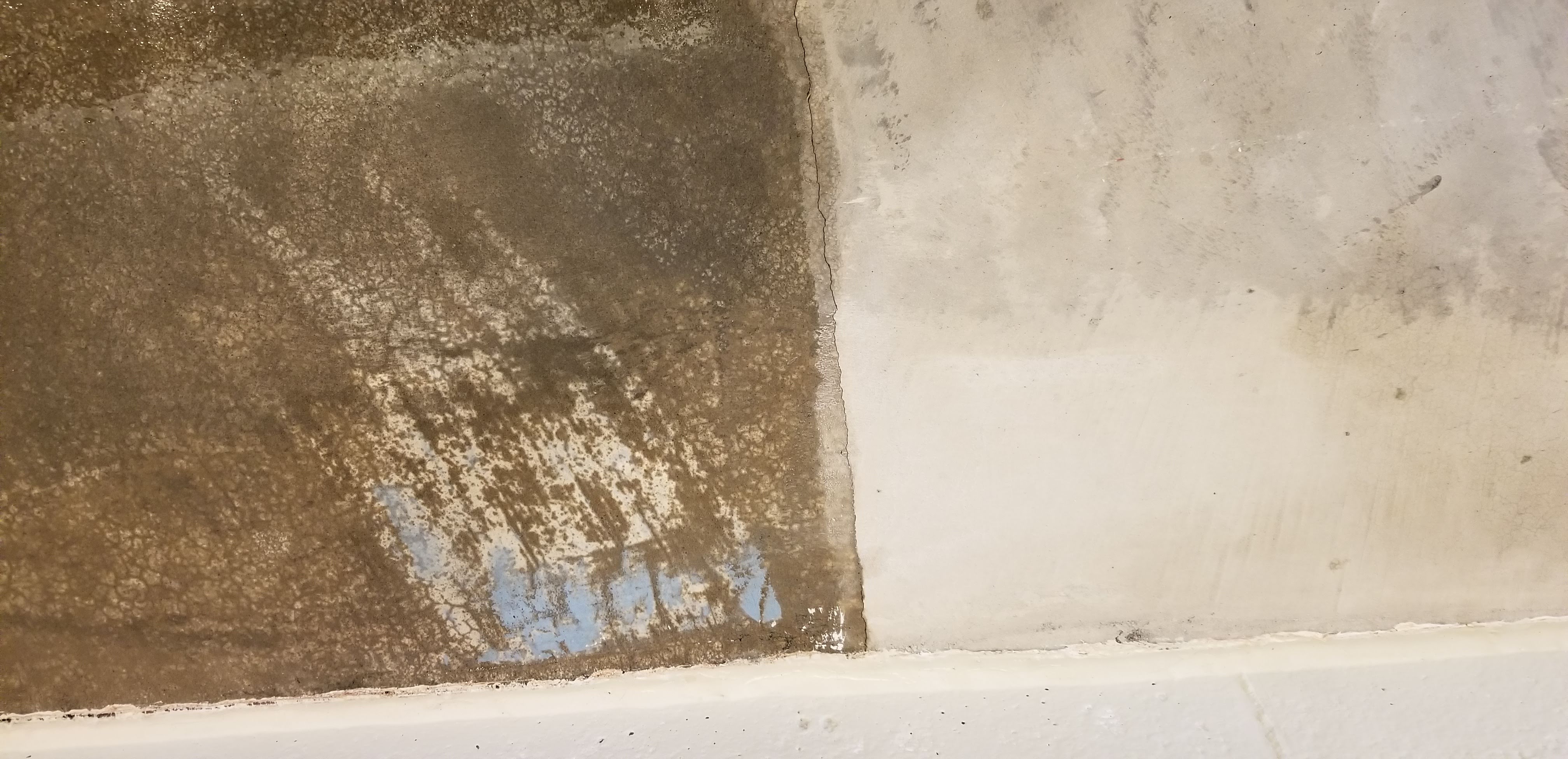
I applied it the same way I did for the hardwood flooring on the main level. I also broke it up into sections, using the preformed contraction joints in the concrete slab as a guide.

I knew I’d have several months while other projects were being finished upstairs to figure out another solution.
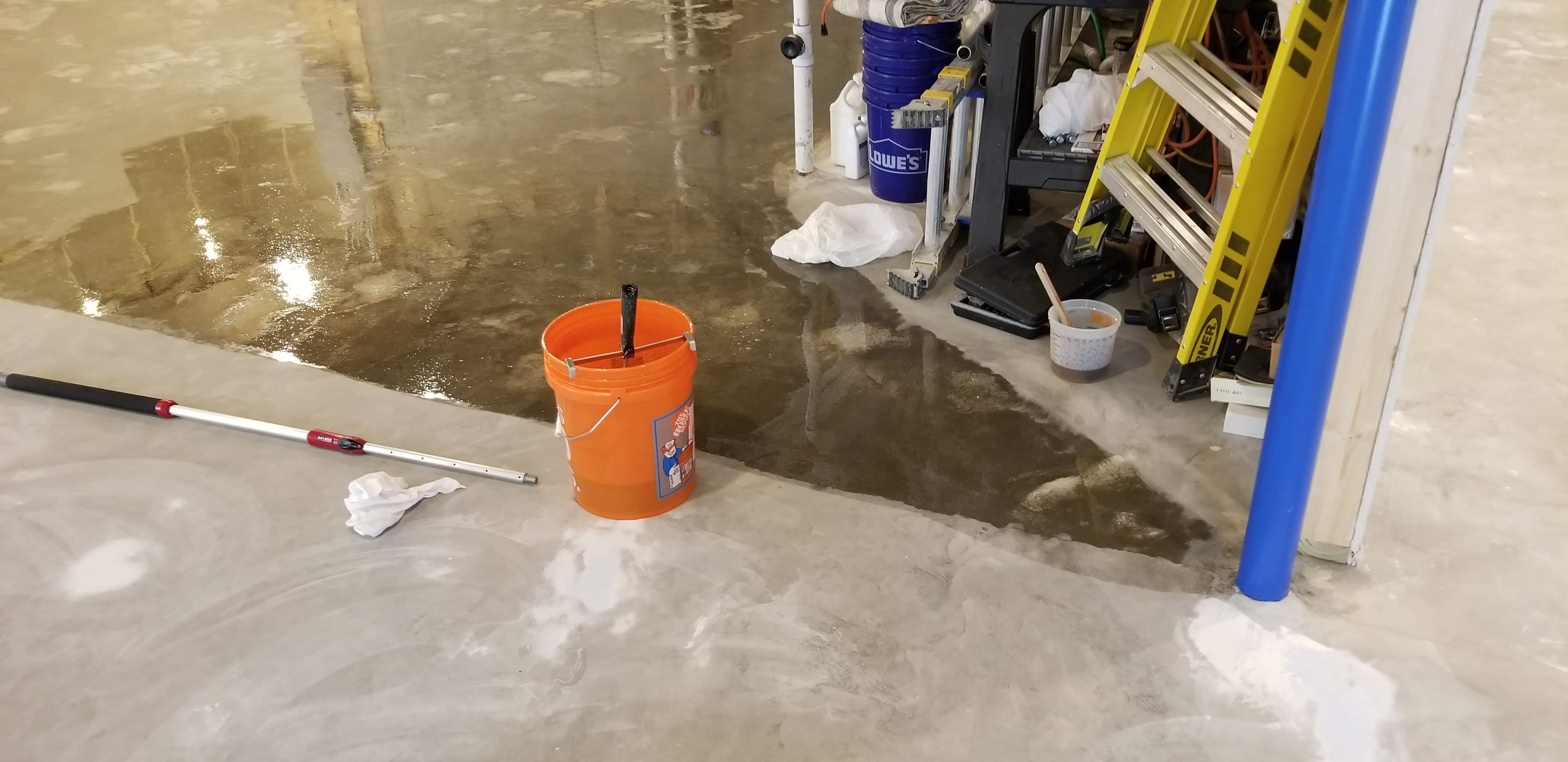
An even closer view after the tung oil has been applied:
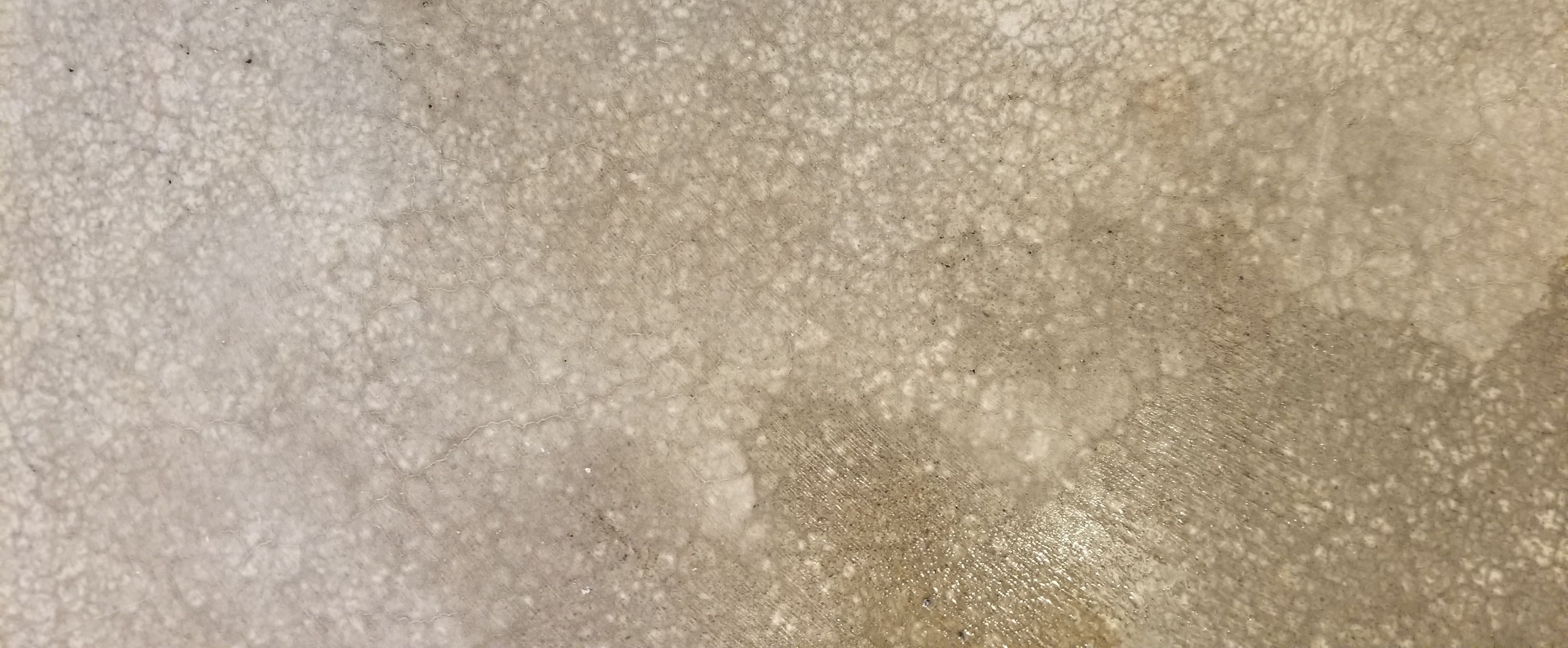
Jackson Pollock as Inspiration
After almost a year had passed, and with much of the work on the first floor finally complete, it was time to come back and finish up the basement floor.
My first thought was to use the painting techniques of Jackson Pollock as an inspiration.
After looking through online photo galleries of his work and watching some videos, I realized I’d forgotten just how layered much of his work is.
It was while researching his work that I also came across an East Coast (mainly New York?) beach house tradition of splatter painting floors, done mainly, it seems, to hide the sand and mess brought in from the beach, all while giving the floors some added durability.
We decided we’d try to mimic some of Pollock’s technique, but do it in lighter layers so more of the tung oiled concrete could show through.
Since it was too cold at the time to have Green Building Supply ship me all of the paint required, we decided to take a trip to Madison, Wisconsin for the weekend to pick up the remainder of what I needed from Premier Paint and Wallpaper.
Premier is a really nice family-owned independent paint store with a wide variety of brands and products. The paint stores around us are exclusively national chains like Sherwin Williams, Benjamin Moore, or PPG. When you walk into these stores you definitely feel the difference compared to a mom and pop operation.
Premier mixed up what we needed, and we were off to enjoy the rest of our weekend in Madison where there’s always something to do outdoors, and there’s no shortage of great restaurants, like Sal’s Tomato Pies:
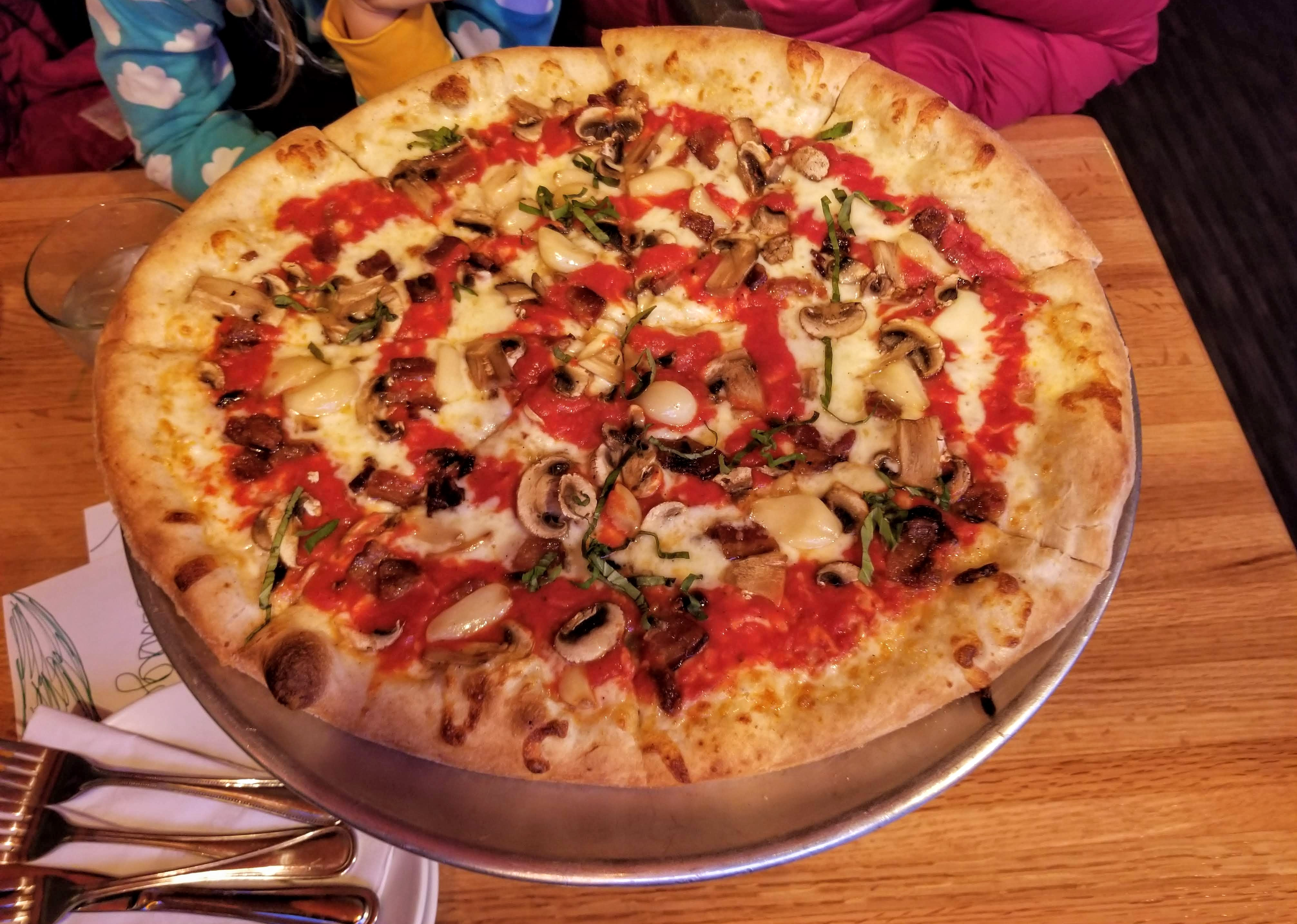
In terms of colors for our splatter technique, we decided to stick with the blue we had used for the basement steel beam and columns, along with white as a neutral color, while finishing with a bright green to liven things up a bit. This combination mimics the iconic color scheme used by Kawasaki motorcycles:
With the walls prepped to prevent overspray from the splatter hitting them, my daughter and I started to experiment in the back corner of the basement with the white color first. We felt like the white color would be the best option as our base coat color, complementing the now tung oil darkened color of the concrete.
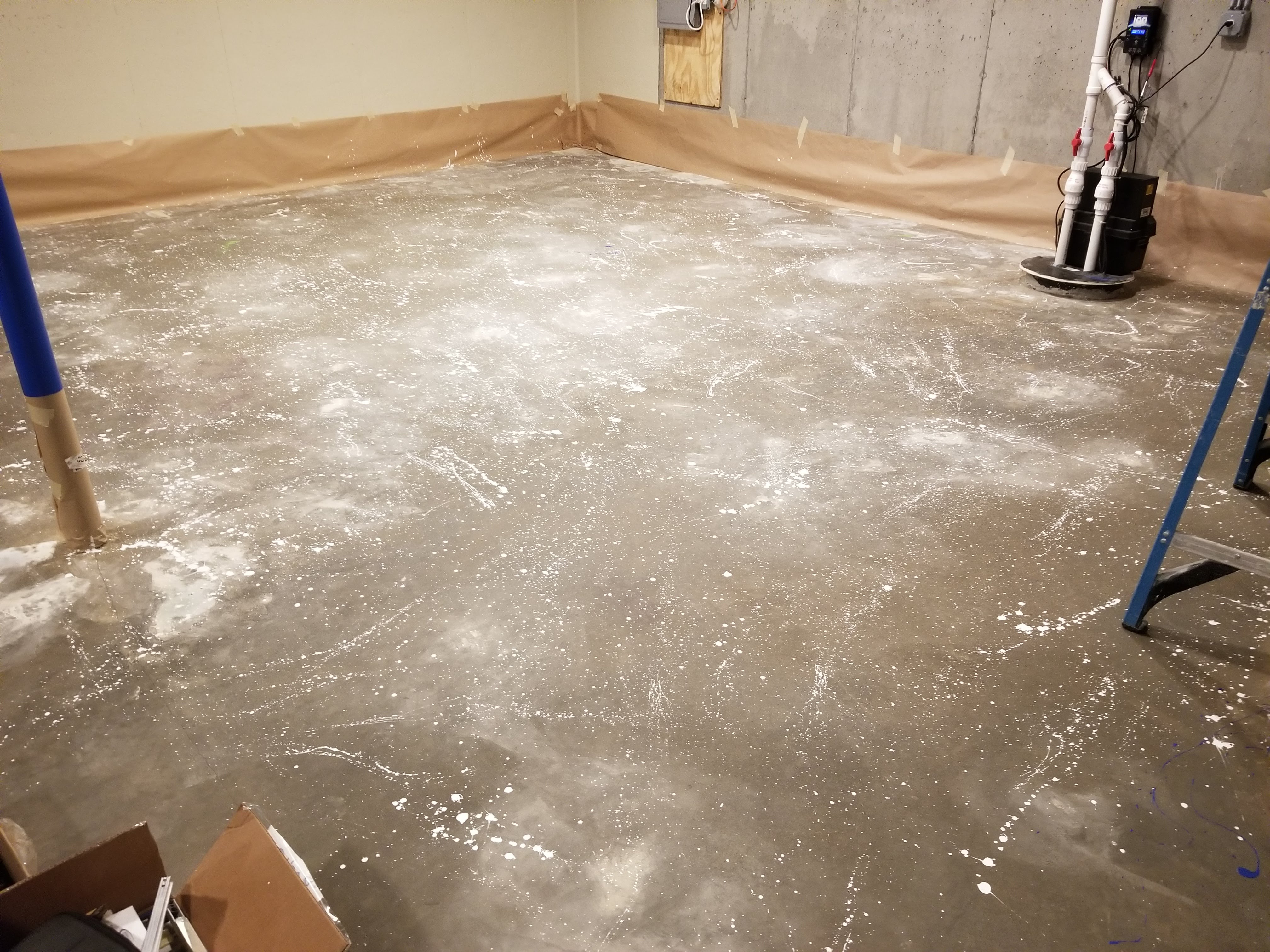
We also took our time to experiment with the other colors, figuring out exactly how we wanted the paint to fall on the concrete — either in droplets or in long, stringy patterns.
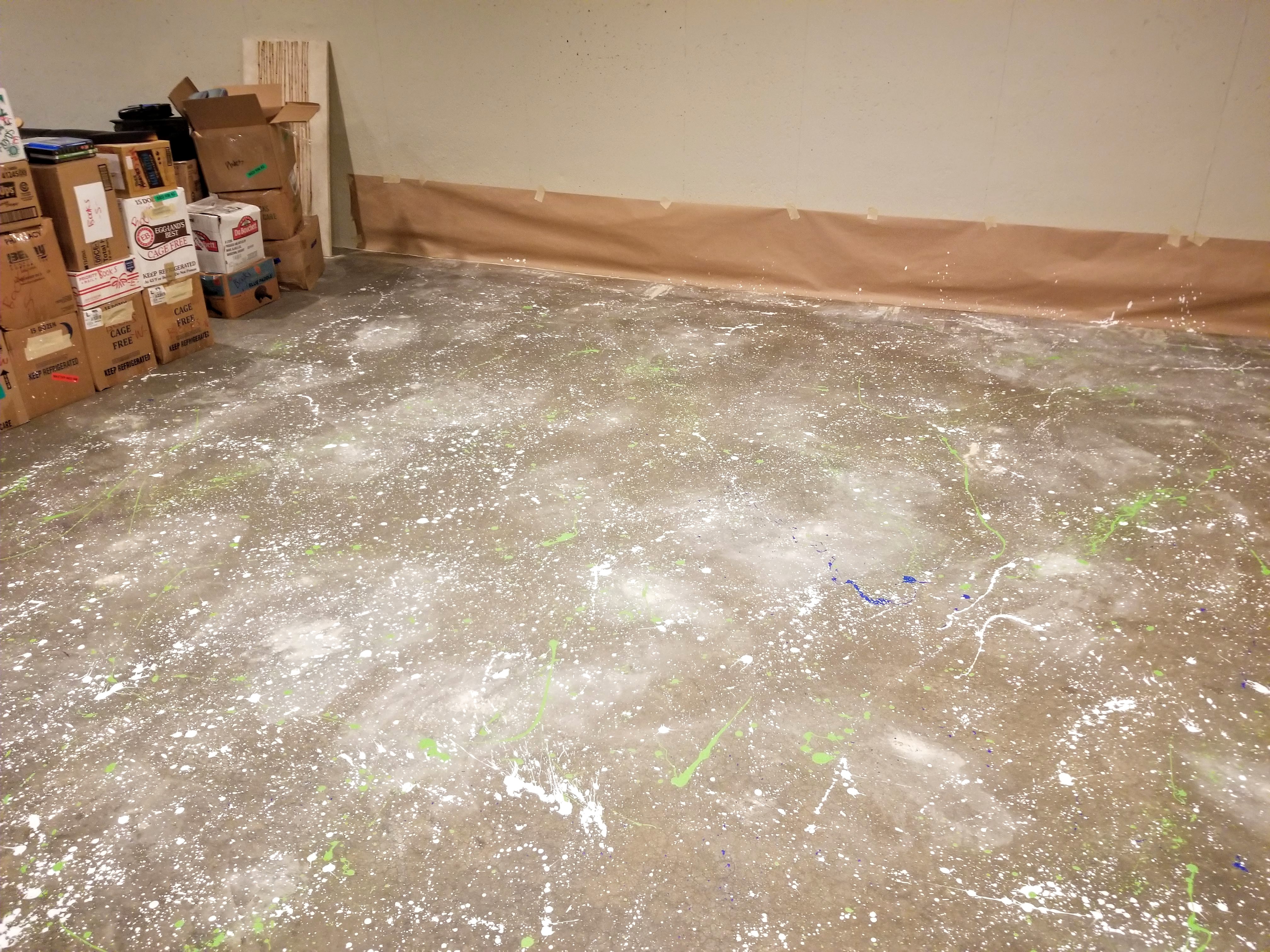
Based on this first section, we felt like we could go fairly heavy with the white and still have some of the darker tones of the concrete underneath come through the final finish. In each section we first started with the white to establish a base coat to work off of for the subsequent applications of the blue and then green.
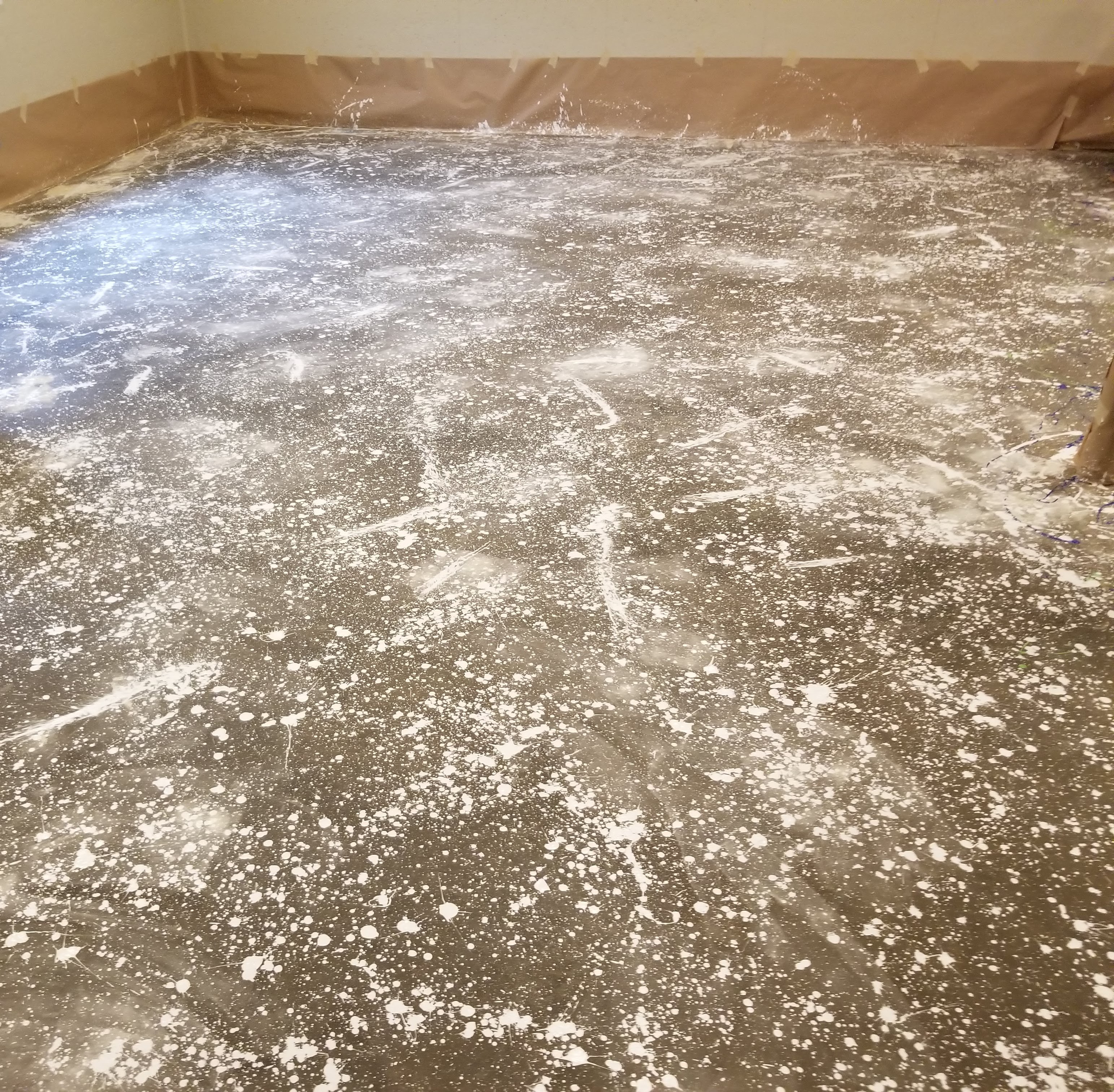
We then played around with how much blue and green we wanted to finish up with on top of the white and the darker concrete underneath.
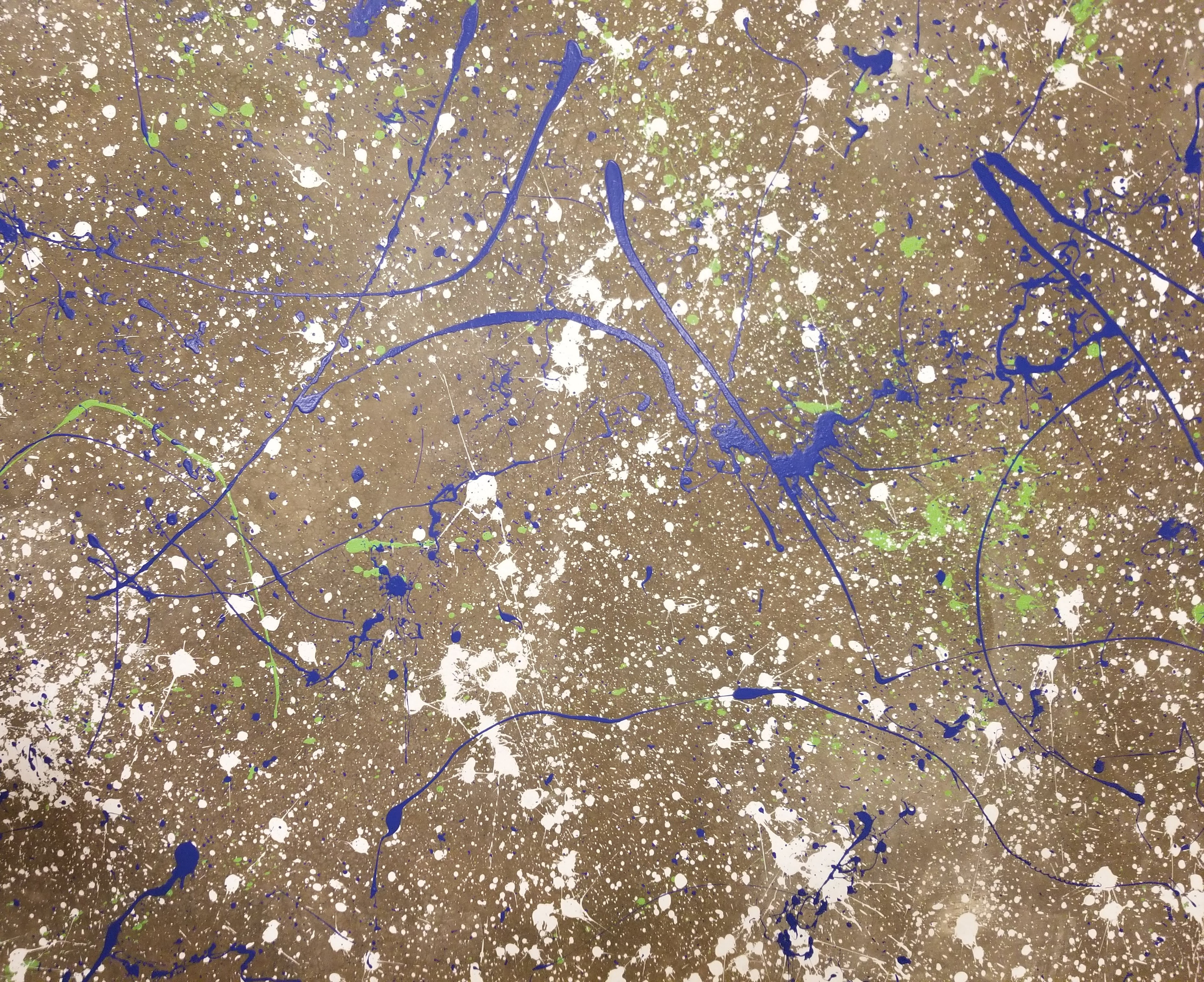
Here’s one of the first completed areas around a steel post or lally column:

A second view of a completed area, this time out in the middle of the floor:
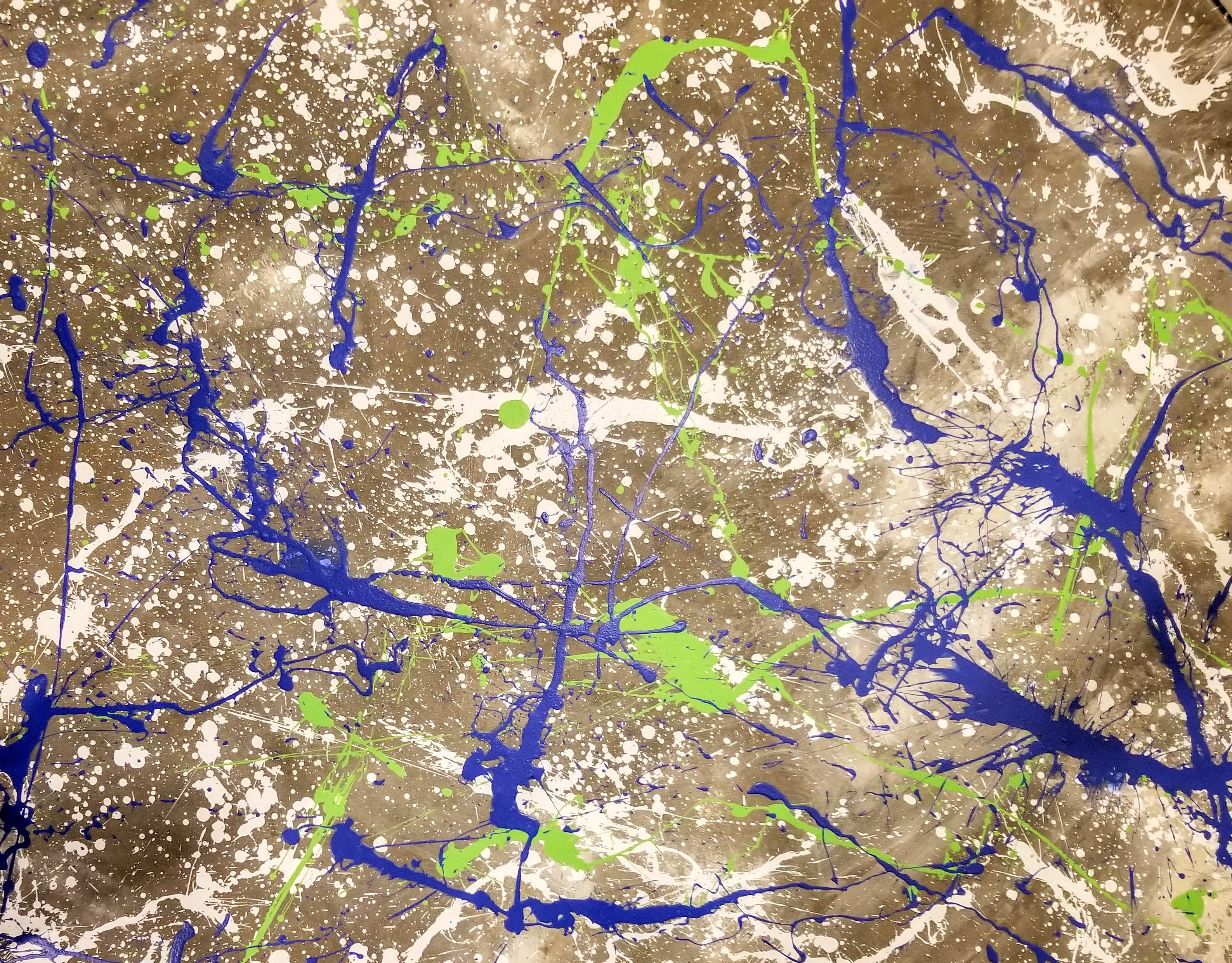
As we finished up a section, we would start to sort through the remaining moving boxes and put together each space more permanently. It was also a good opportunity to further purge anything still in boxes that we didn’t end up needing in our new home.
For one area of books we used the traditional set-up of cinder blocks and wood shelves, but we added some character by taking the time to paint the blocks using the floor colors. We also turned the blocks on their side to hide their empty centers. I had seen this technique used in a YouTube video as a way to dress up this type of shelving normally associated with a college dorm room or one’s first apartment:
It definitely added some time to the project as each block required a couple coats of paint, but it was a nice way for my daughter and I to have some more fun with color, too.
This section of books on cinder blocks helps to close off and define this sitting and reading area from the storage and arts and crafts area behind it.
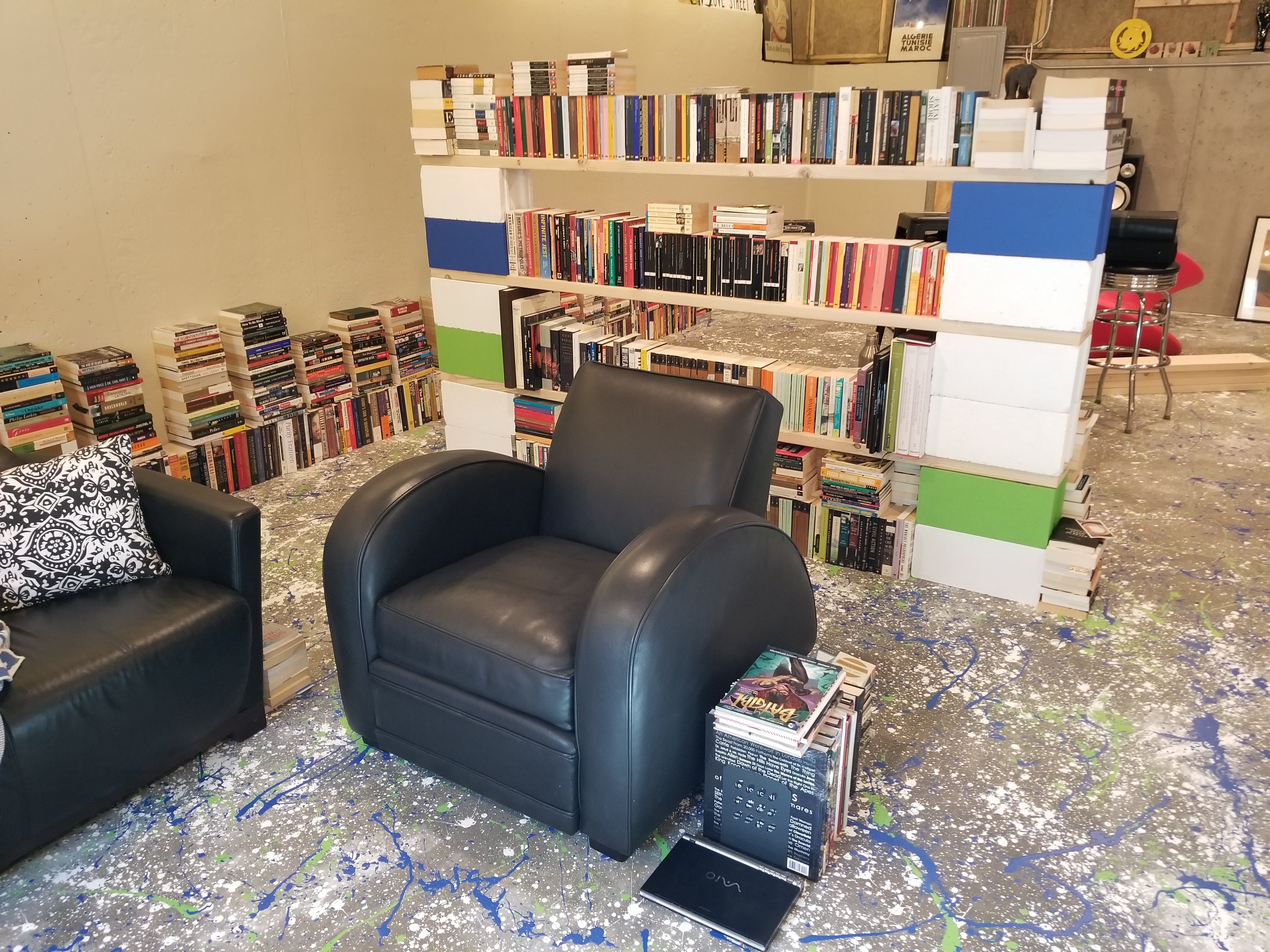
We were pleasantly surprised by the wide variety of looks, textures, and playful randomness in the overall pattern of the paint splatter.
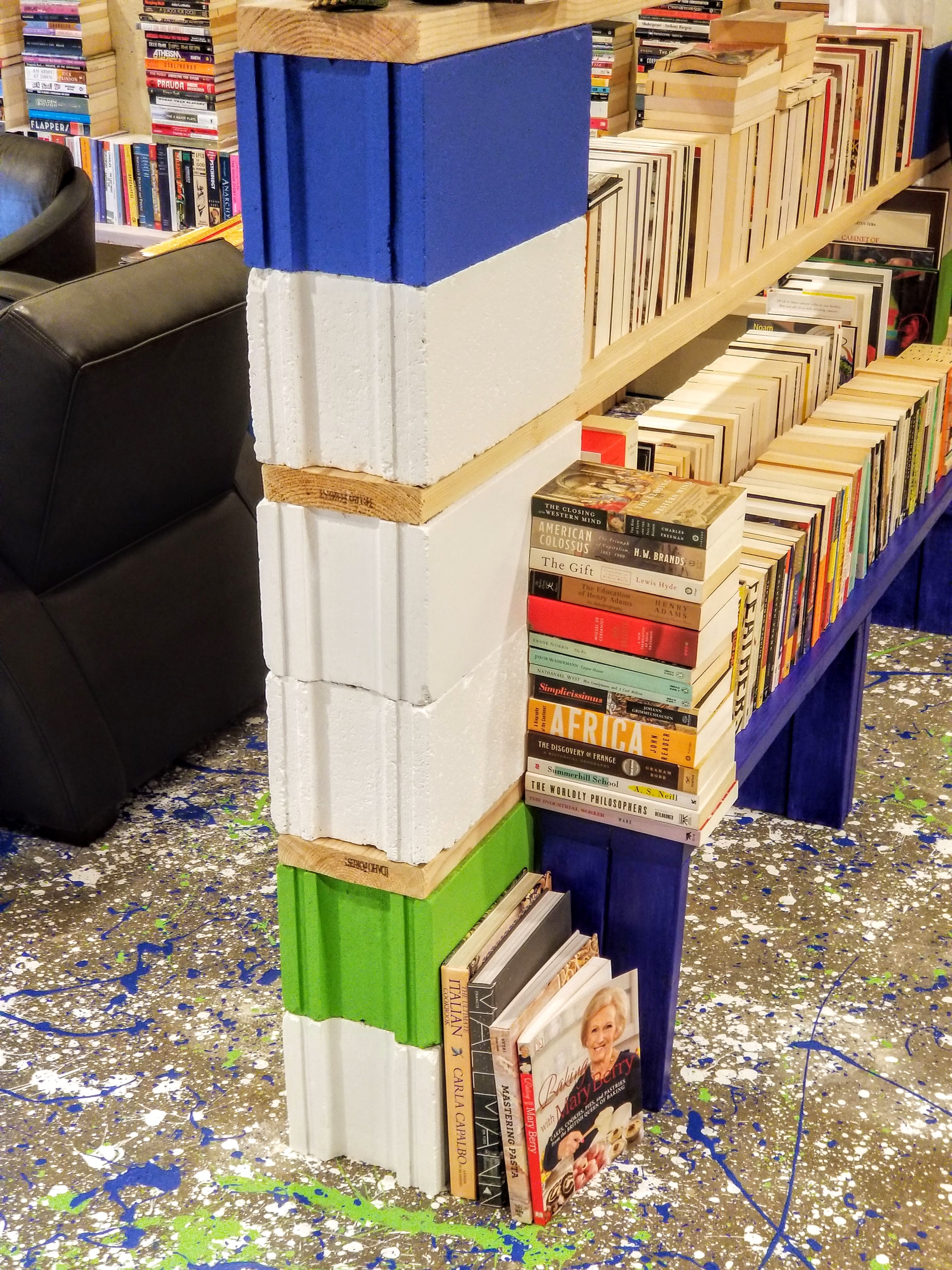
It’s definitely unpredictable to a great degree, but with practice it did become easier to control, and we did develop a feel for how we wanted each area to end up looking.
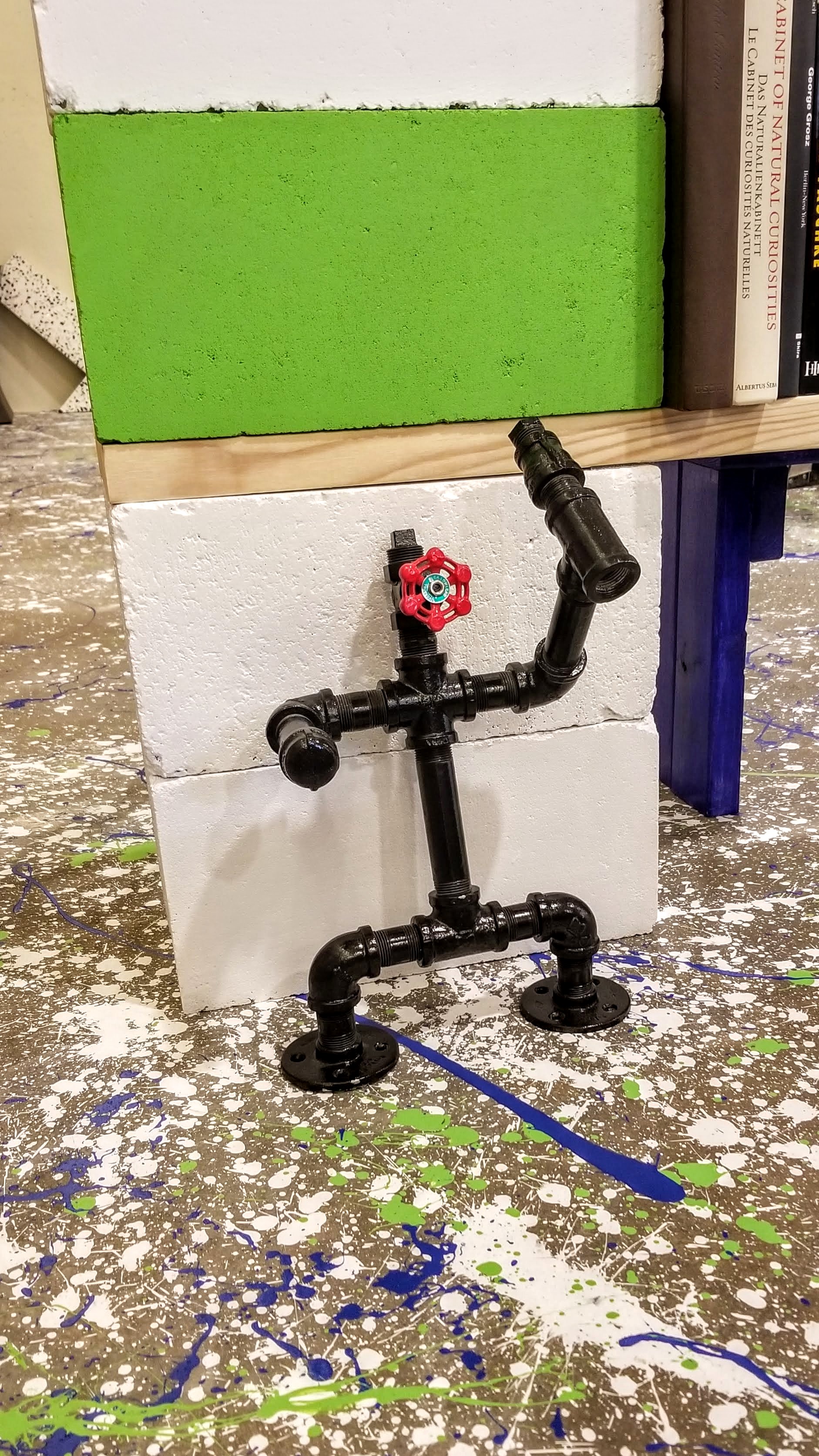
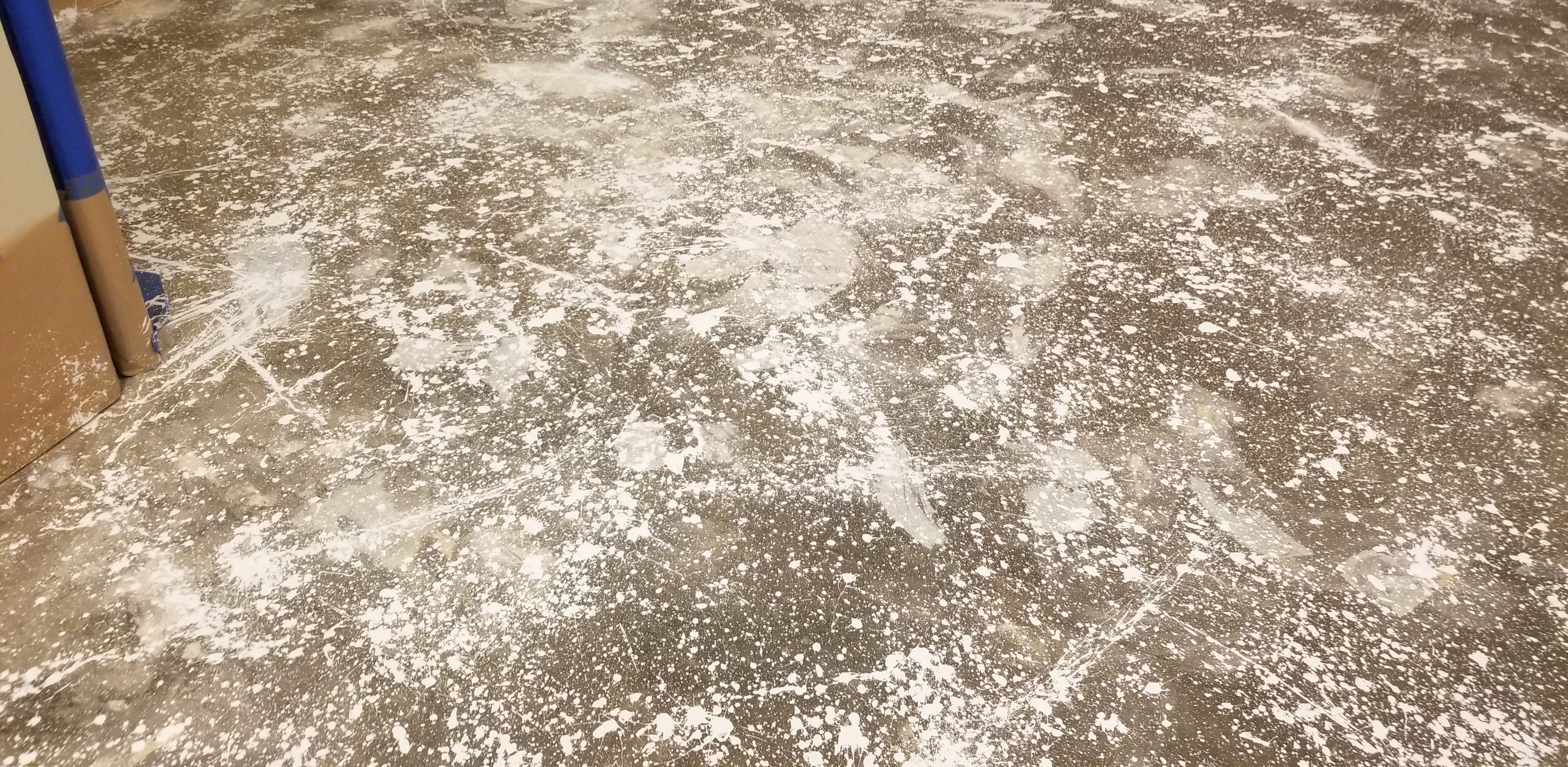
Here are several close-ups showing some of the texture created by the splattered paint, whether as drops or longer, stringy ropes.
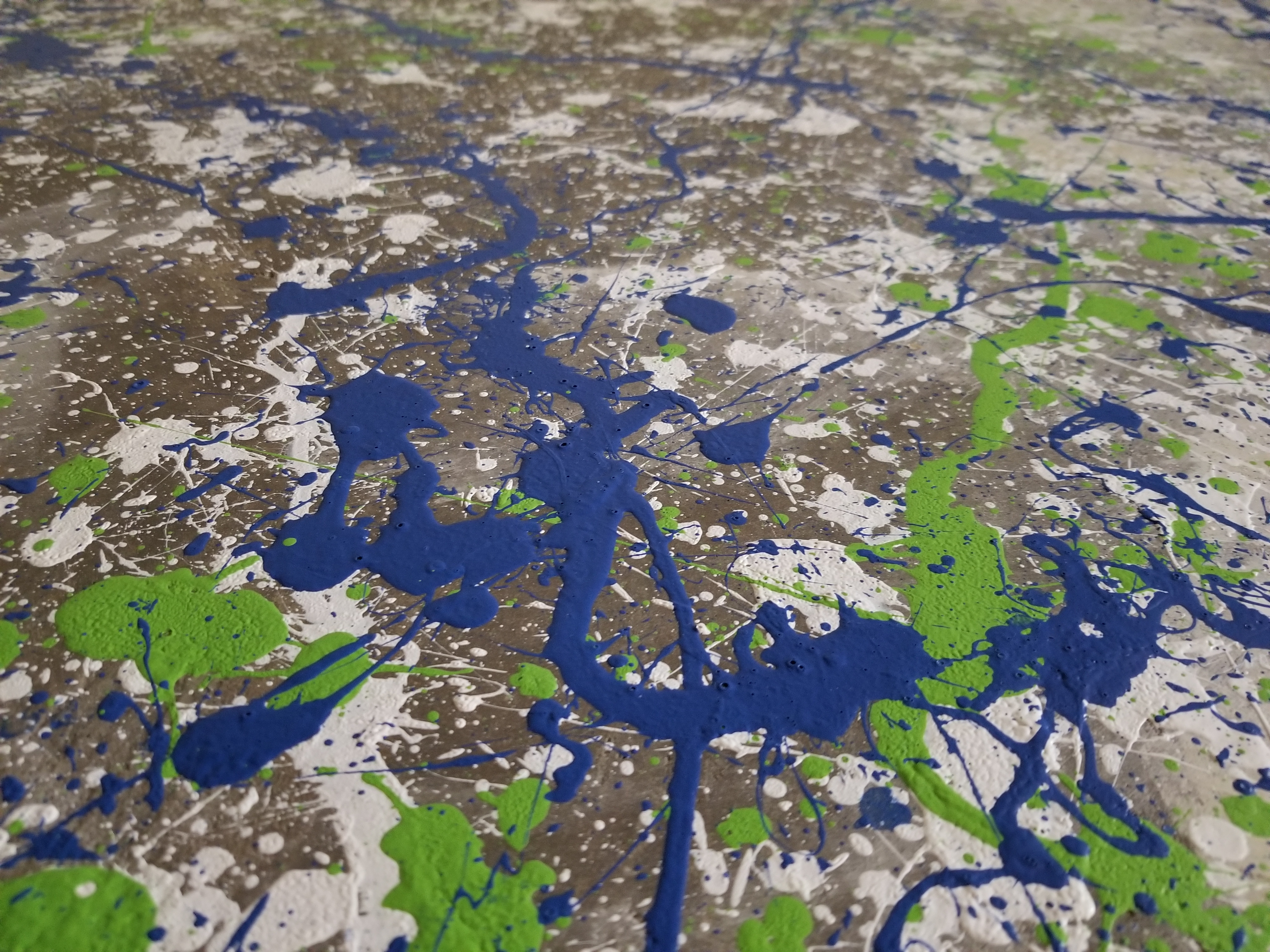
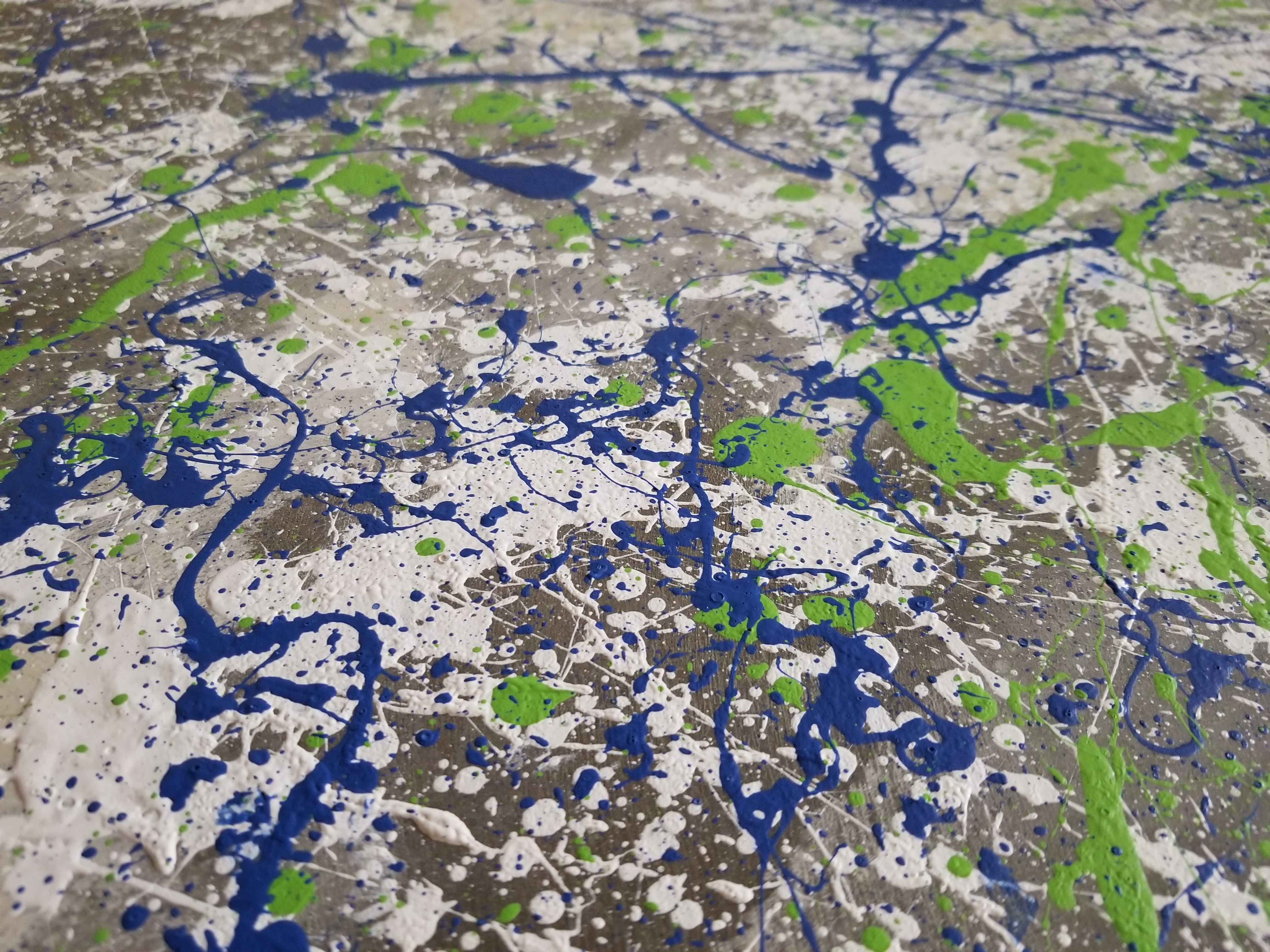
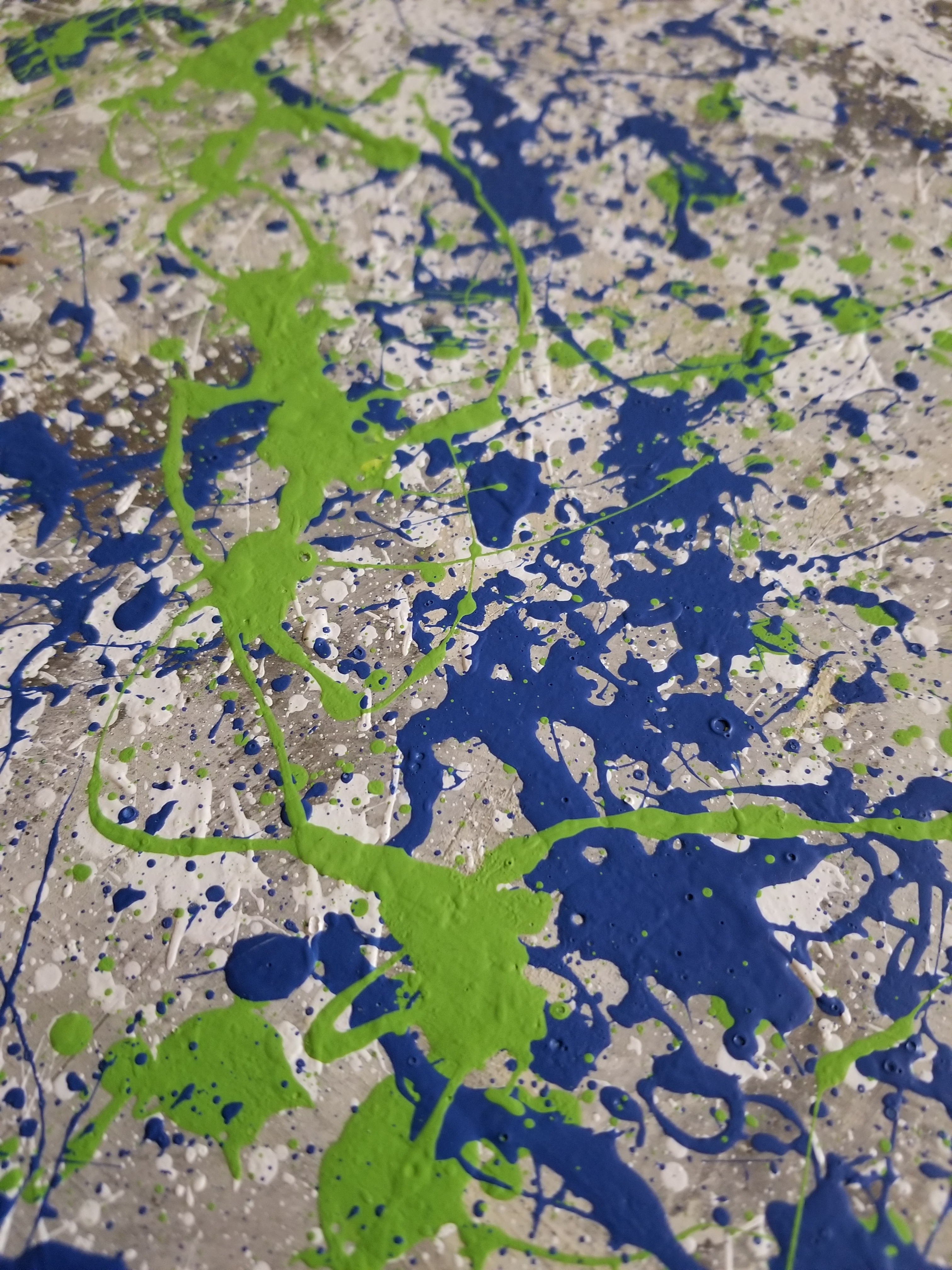
A wider shot showing the layering of the three colors, with the darkened concrete and some of the slurry patches still visible underneath.

We weren’t afraid to leave some areas with a lighter application of paint. The mix of light and heavier areas of coverage helps to give the floor visual interest, and it hopefully emphasizes the human element involved in the final look of the finish.
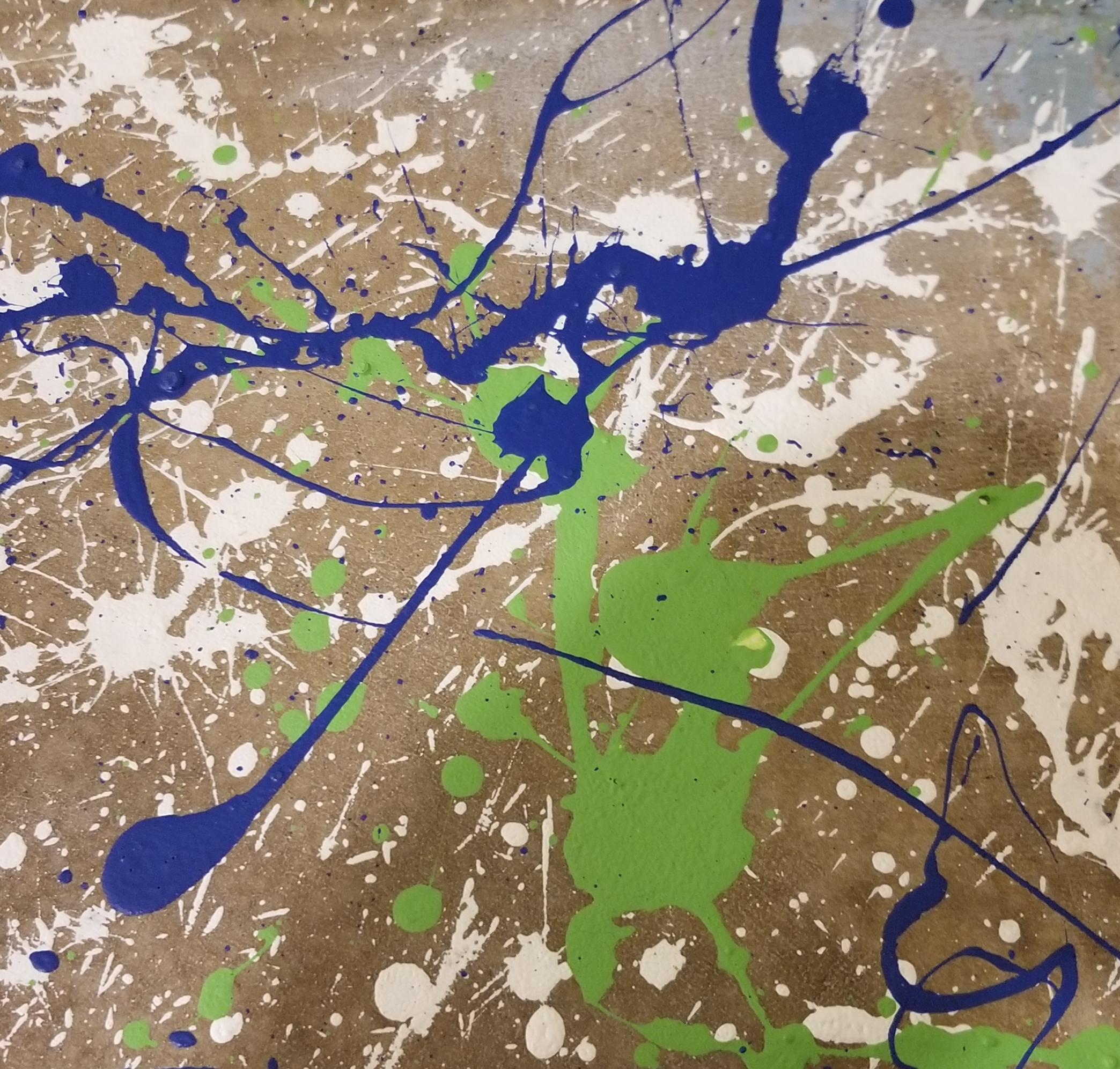
Once the white paint was applied, we would let it dry overnight. The next day we would come back and apply the blue.
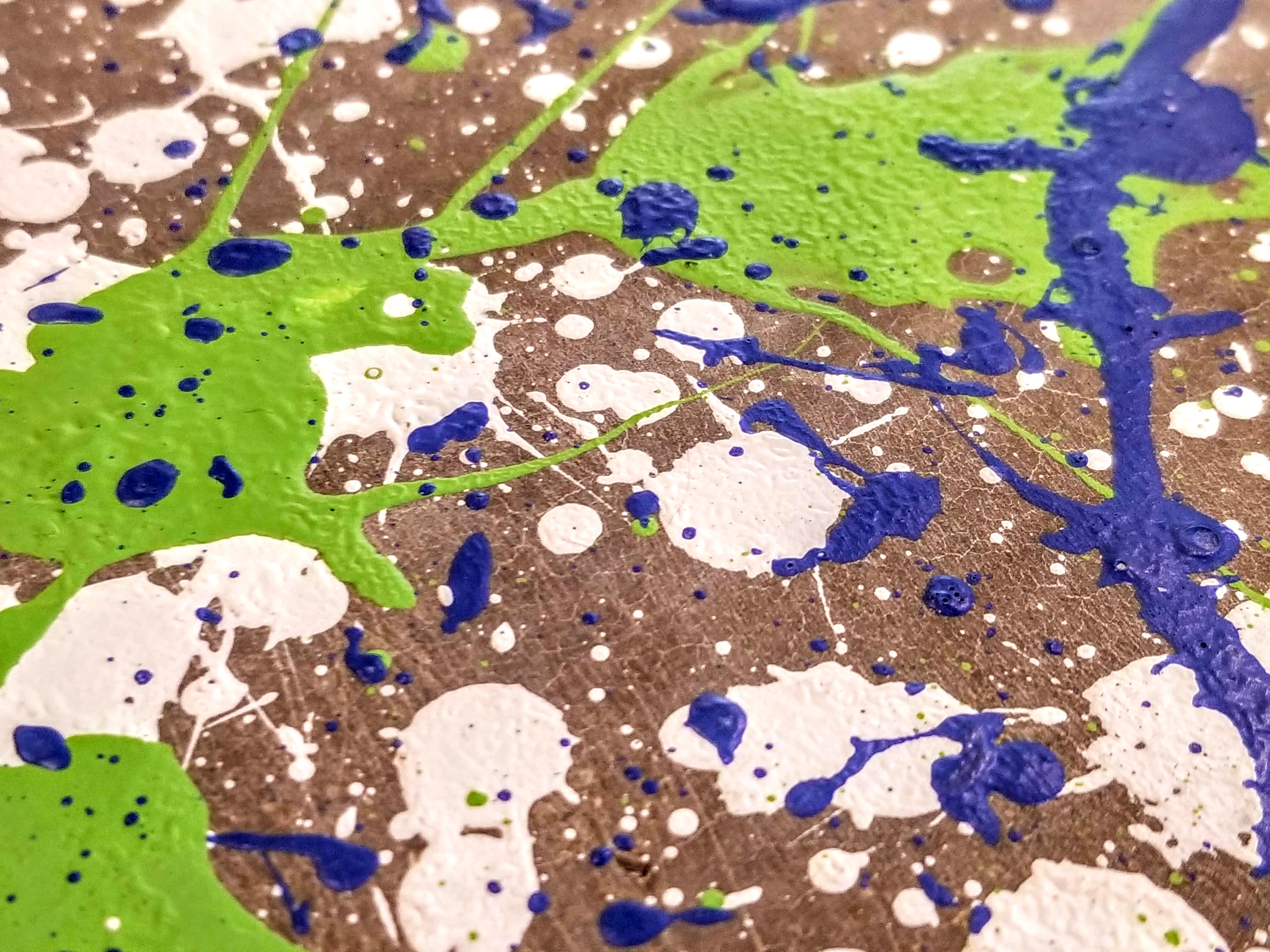
Since each color would have areas of fairly heavy coverage, after the white was down we always applied the blue and green coats in our socks to avoid even the possibility of our shoes pulling up any areas of uncured paint.
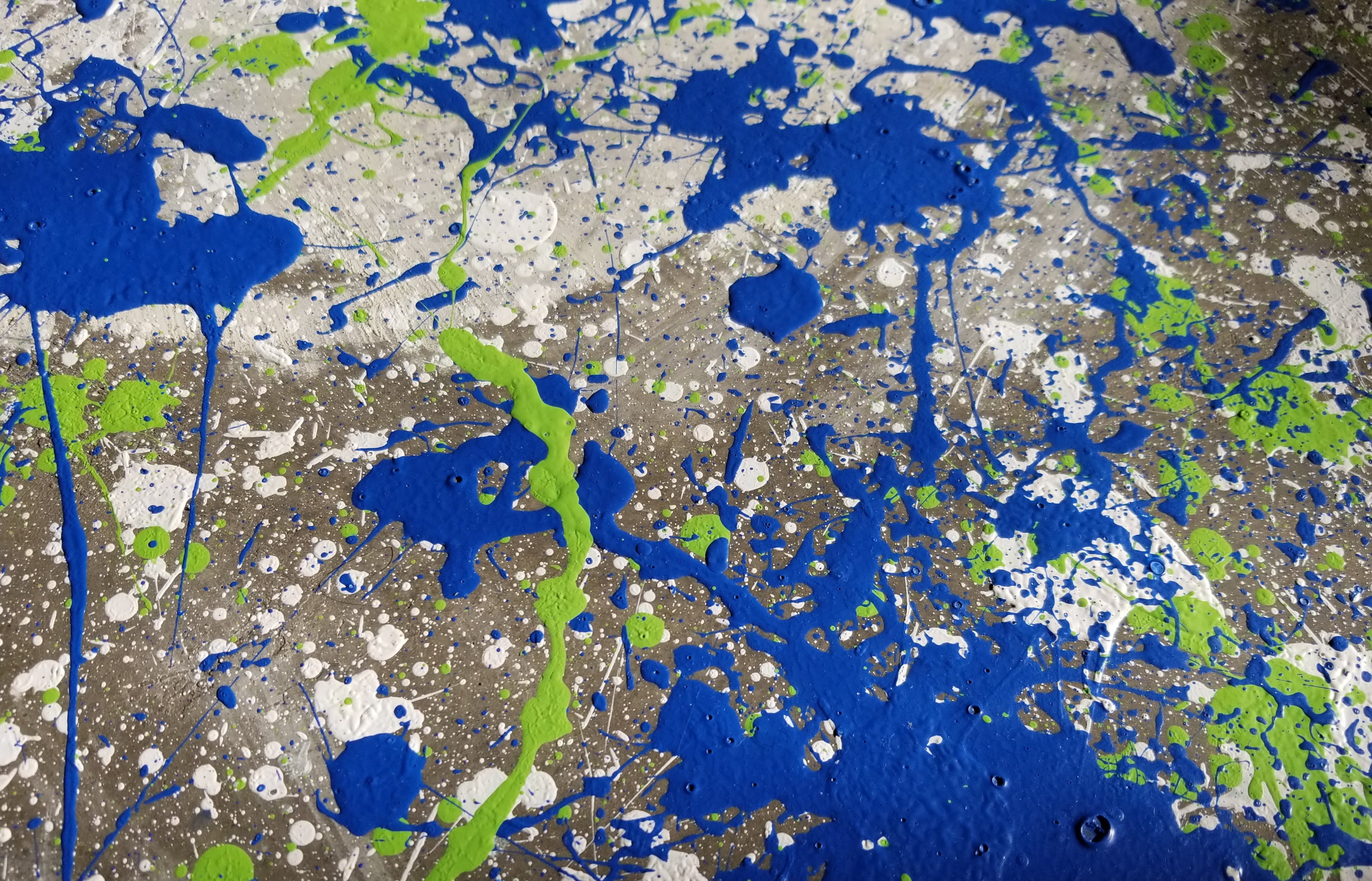
Most of the photos show the colors in daylight, with the sun coming through the two basement windows, but we’re equally happy with how the floor looks under artificial light at night.
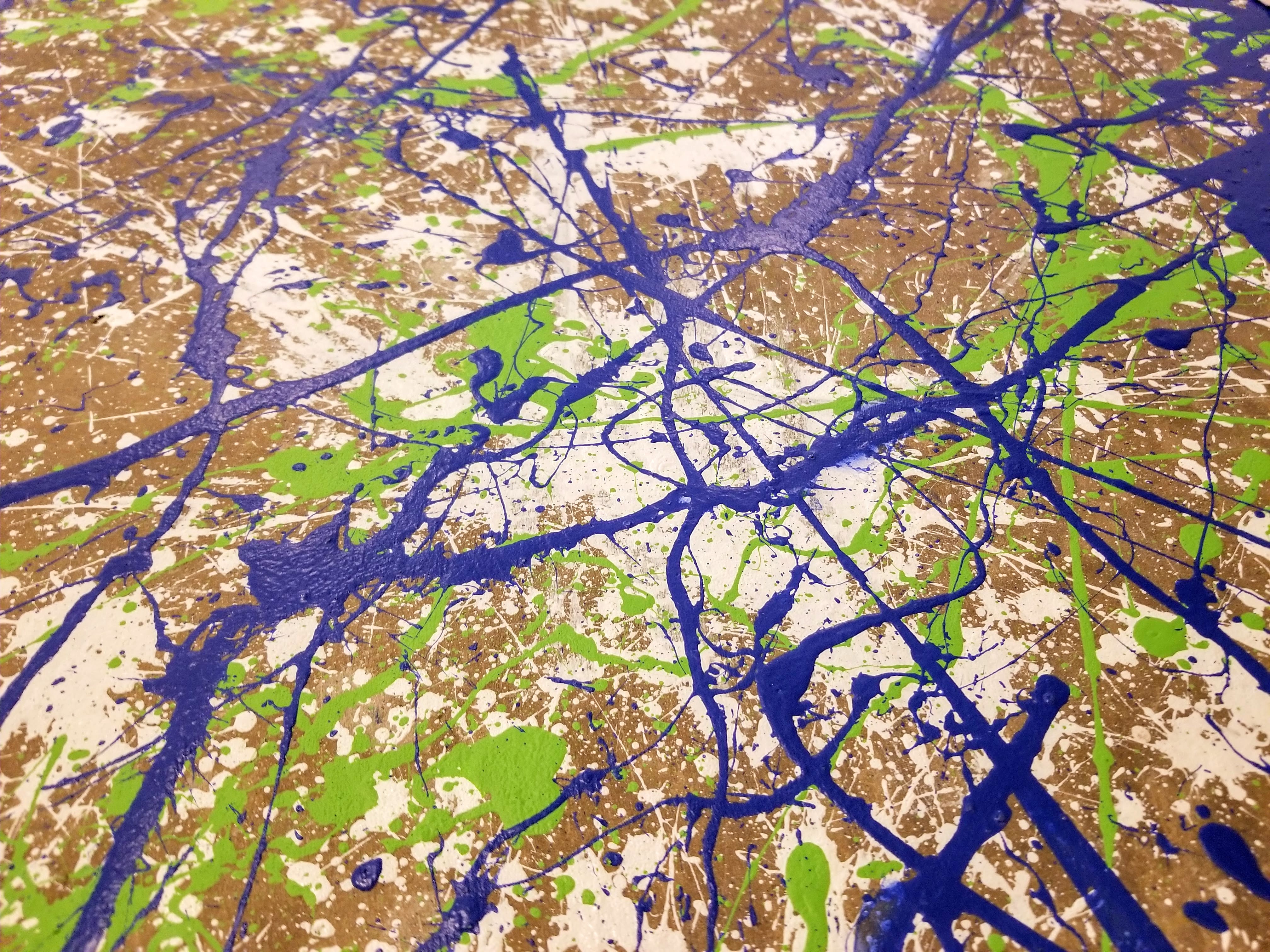
We typically gave the blue 24 hours to dry as well, although there were a couple of times where we waited only about 6-8 hours before starting the green. With less paint on the floor, it seemed to take the blue less time to sufficiently dry.
The goal was to apply less paint with each change in color. We definitely wanted the white to remain the main background color, with the blue and the green acting as pops of accent color.

When the floors had only been sealed with the tung oil, although it solved the concrete dust issue, it did make several areas slippery smooth. Because the paint splatter hits the concrete in various thicknesses, the slightly uneven texture this produces helps make the final finish slip resistant. Even with this high build in some spots it’s never been a problem; instead, this texture is pleasant both underfoot or even to the touch.
I was a little worried about the thicker areas of paint drying and curing properly, but apart from some bubbles that popped as the paint dried, and some areas where the paint film shows some wrinkling on the surface, we had no issues in this regard.

In addition to being slip resistant, it was also a relatively inexpensive finish to create, requiring just 3 gallons of white, 2 gallons of blue, and a single gallon of the green. This was in addition to the initial tung oil and citrus solvent (around 4-5 gallons of each) that we had applied to first seal the concrete. For slightly less than a dollar a square foot, the paint splatter technique produces a unique, one of a kind floor finish.
And the choice of colors is limited only by one’s imagination. We even contemplated adding some stencils that could’ve incorporated numbers, letters or words, or even distinct shapes. Instead, we decided to keep things simple and stick with just the splatter pattern. Nevertheless, there’s no reason not to explore all of these options before settling on a final design.
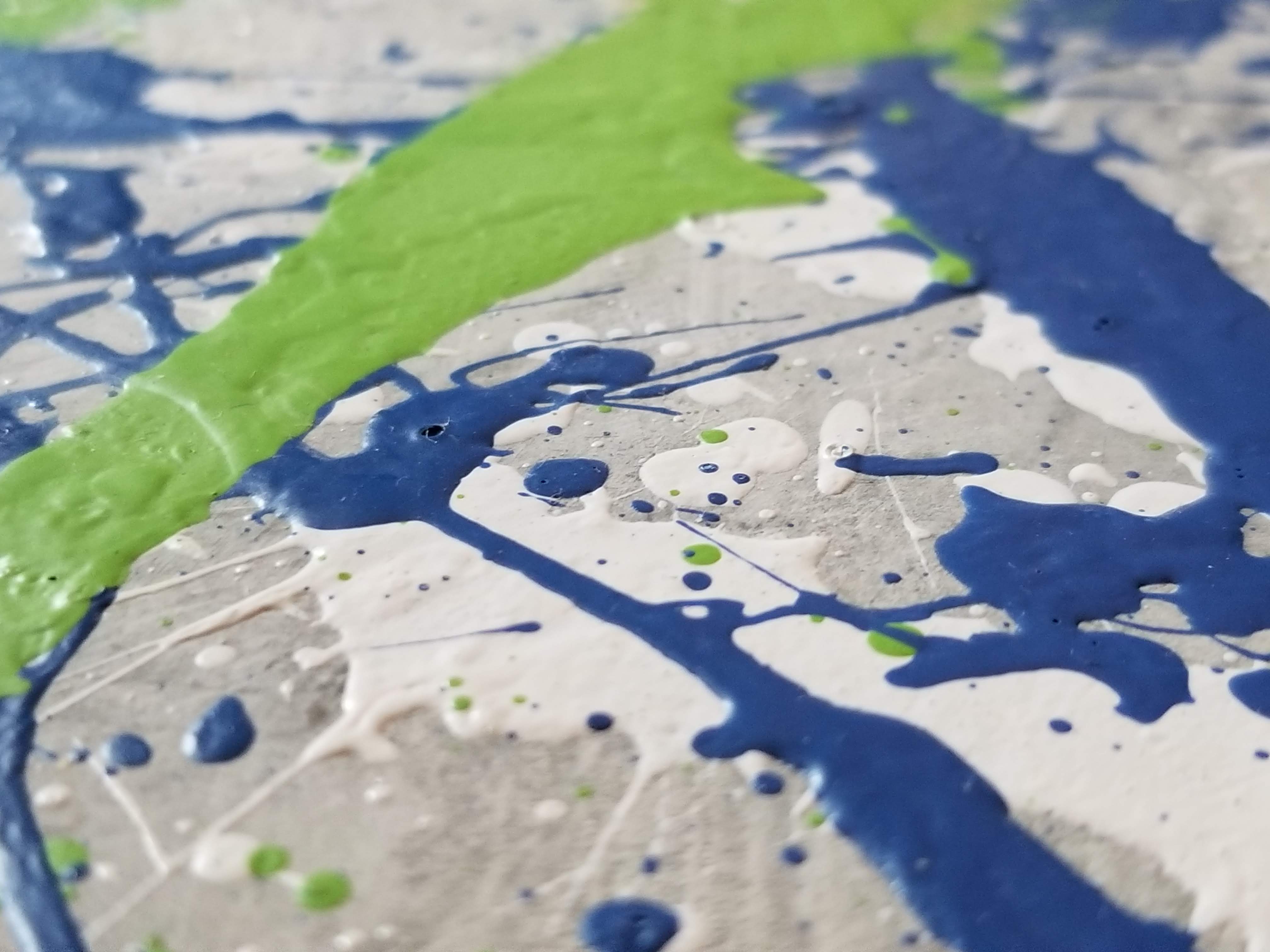
One other key advantage to the paint splatter is that if any part of the floor were to see damage, whether from abrasion or moisture pushing the paint off the concrete, it would be relatively easy to repair with some additional paint applied using the same process.
This would not be the case had we used a single color, cut and rolled the typical way, across the entire basement floor. Any damage, even in a small area, with a single color tends to look horrible, and it would be difficult to correct it without leaving a ‘crater’ look in the area that had peeled and then been repaired.
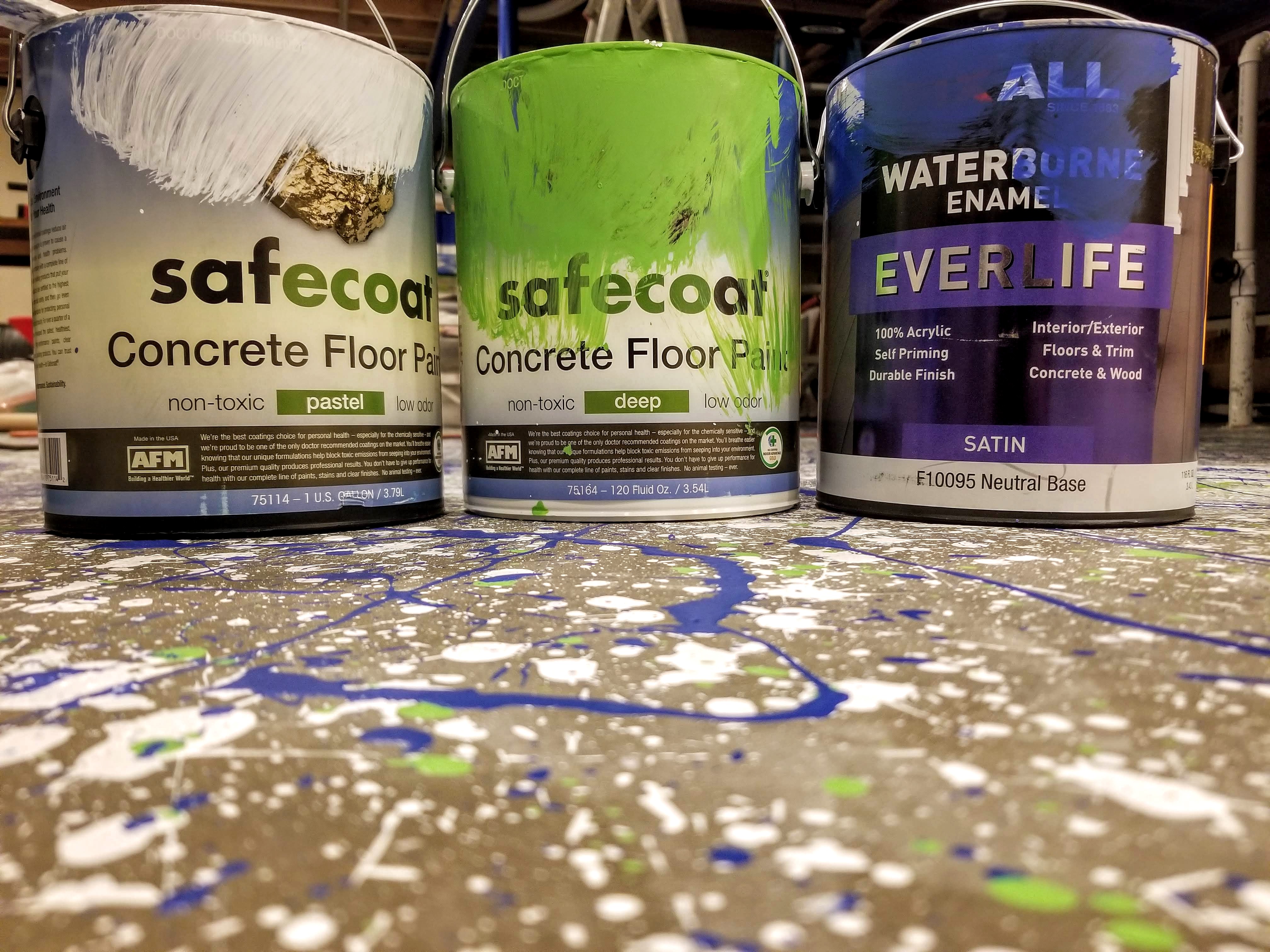
Premier couldn’t mix the blue in the Safecoat product, so we had to use the Fixall enamel instead. Even though it has more VOC’s than the Safecoat, within a couple of days any noticeable smell had dissipated. It probably helps that the total square footage of blue applied is fairly small.

At outside walls we ended up letting the paint hit the Air Dam that’s covering the gap between the slab and the foundation wall (there’s rigid foam below this gap acting as a thermal break between the slab and foundation wall).

Since it was somewhat random how the paint hit this gap, some spots were hit heavily, while most just saw a slight smattering of color in this area.
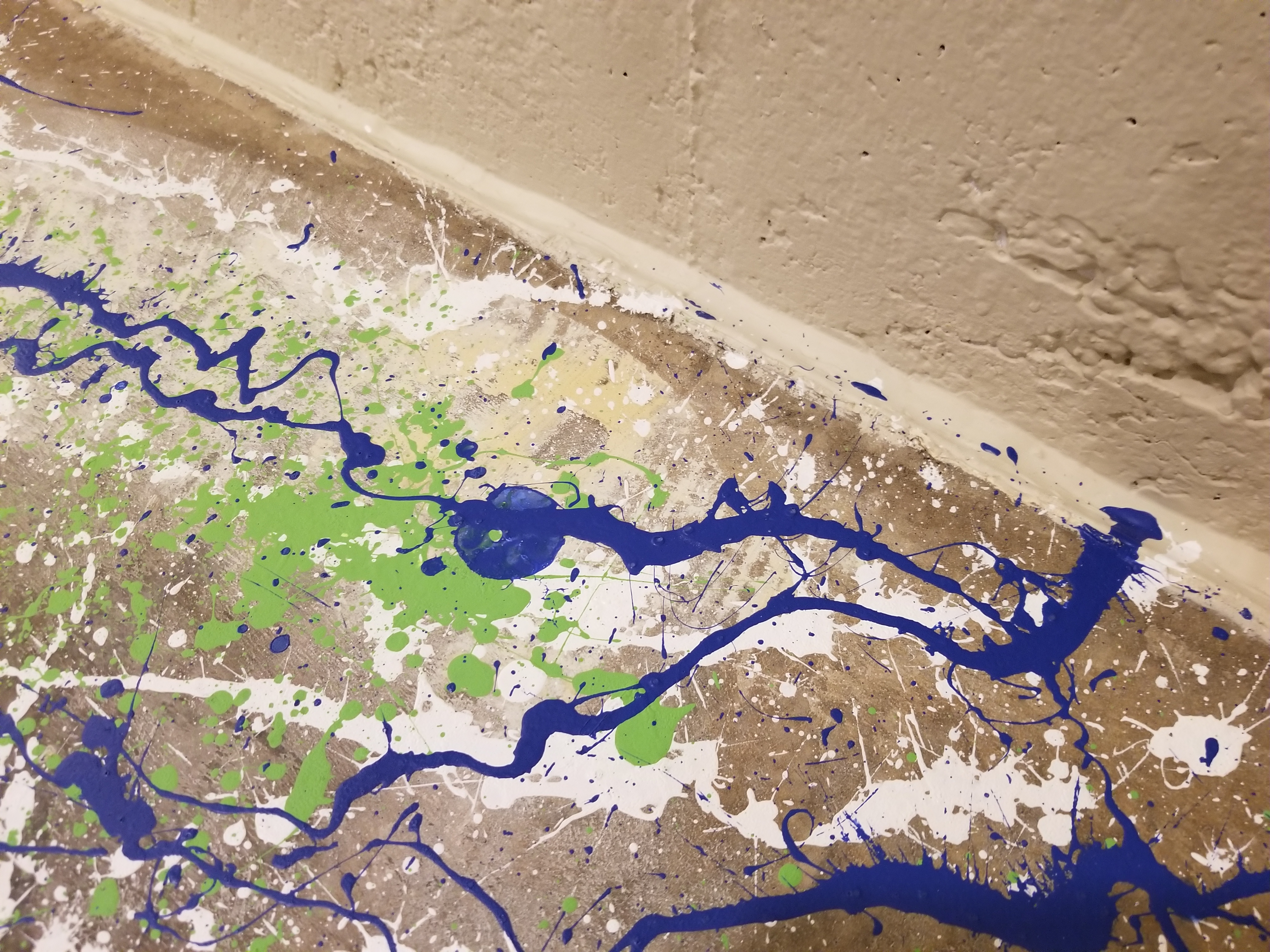
There were only a couple of spots where the paint splatter managed to get behind or beyond the paper we had taped on the walls to protect them. For those spots it was easy to go back and touch them up with a small brush of wall paint.

In terms of technique, we used paint stirring sticks to apply each color. Depending on the effect we wanted, how we worked our wrist determined the pattern of the paint. For example, if we loaded up the stick with a lot of paint, or even just a little, and we flicked the stick hard — like you would using a fly swatter — you could get a lot of drips and ‘dots’ over the floor. With a lot of paint on the stick you ended up with heavy droplets and spray. With less paint, you still had drops and a spray effect, but the coverage was much lighter over the tung oiled concrete.
This worked great for applying the white base coat when we were trying to get a lot of color on the floor all at once, and at different rates of coverage.
For the blue and the green we again loaded up the stick heavily with paint, but with very little movement of the wrist — just with a slow and deliberate arm motion — we let the paint fall off the stick using slowly undulating half-circles, figure eights, and wave motions.
The photo below shows a corner of the basement office with just the slurry patches and the tung oiled finish. With the walls protected, we could begin laying down the three colors of paint splatter.
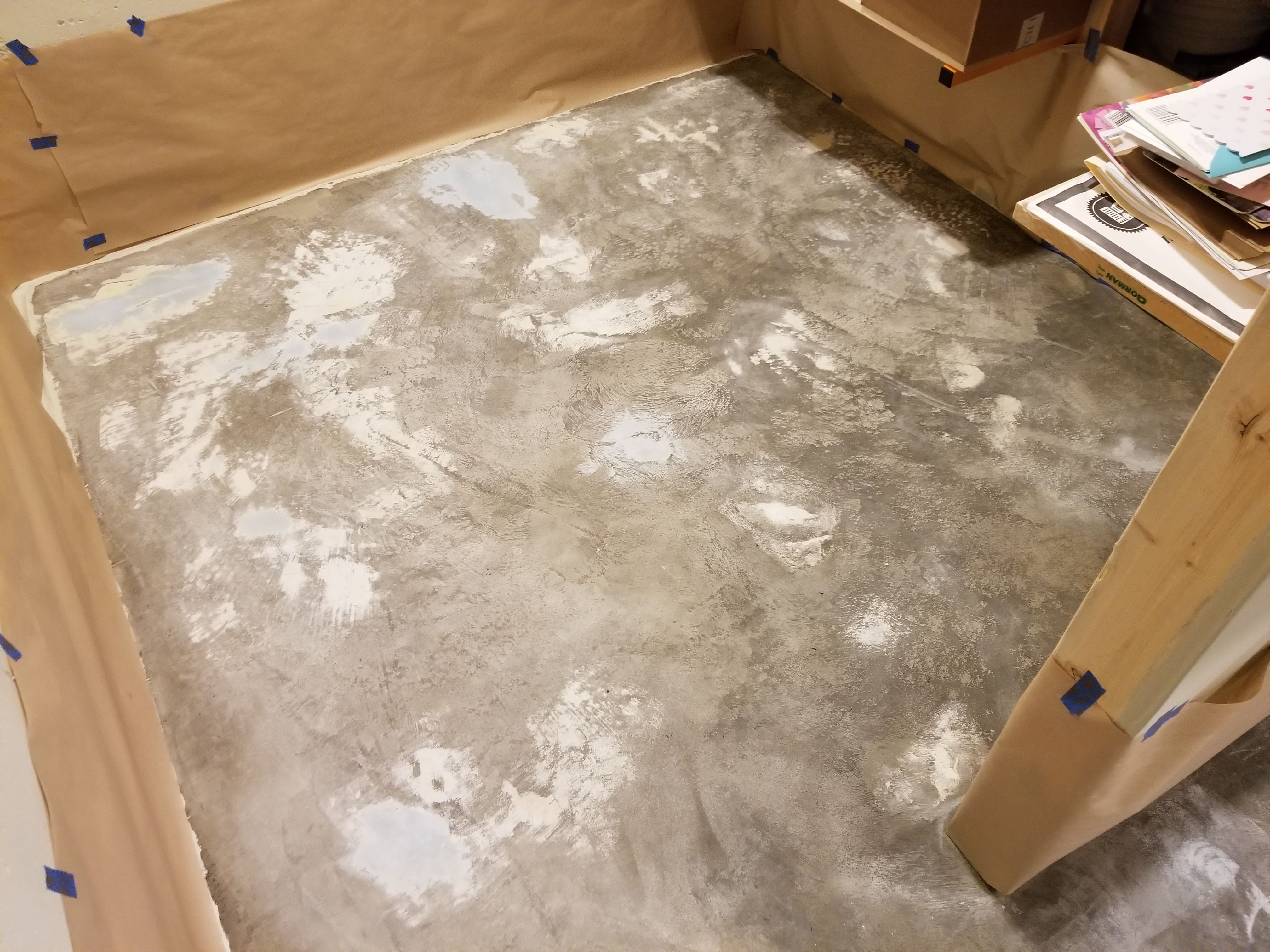
Here’s the same area after the three colors of paint splatter have been applied:

And here’s the main area of the basement office as we were finishing up:
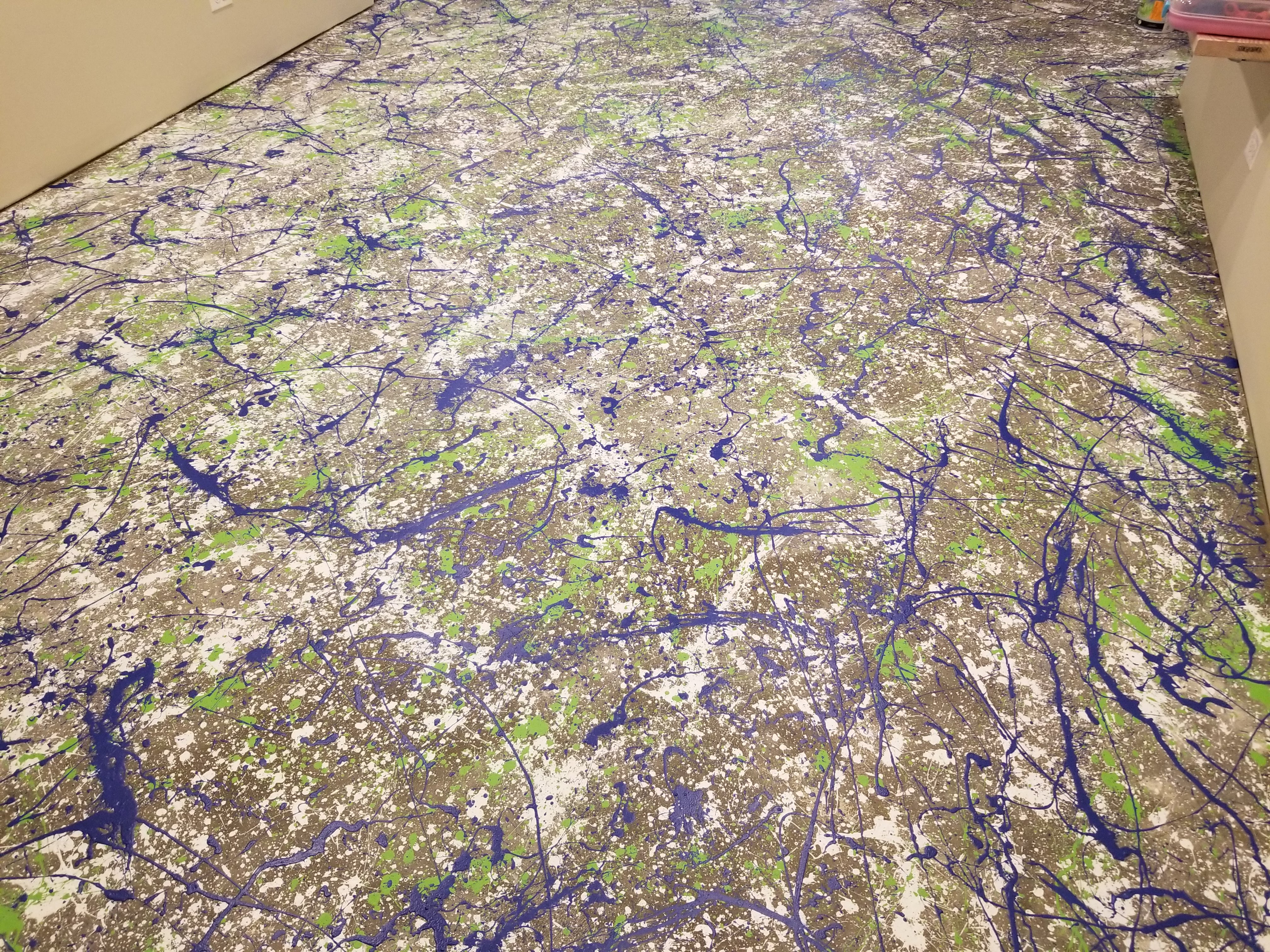
And here’s the foot of the basement stairs:
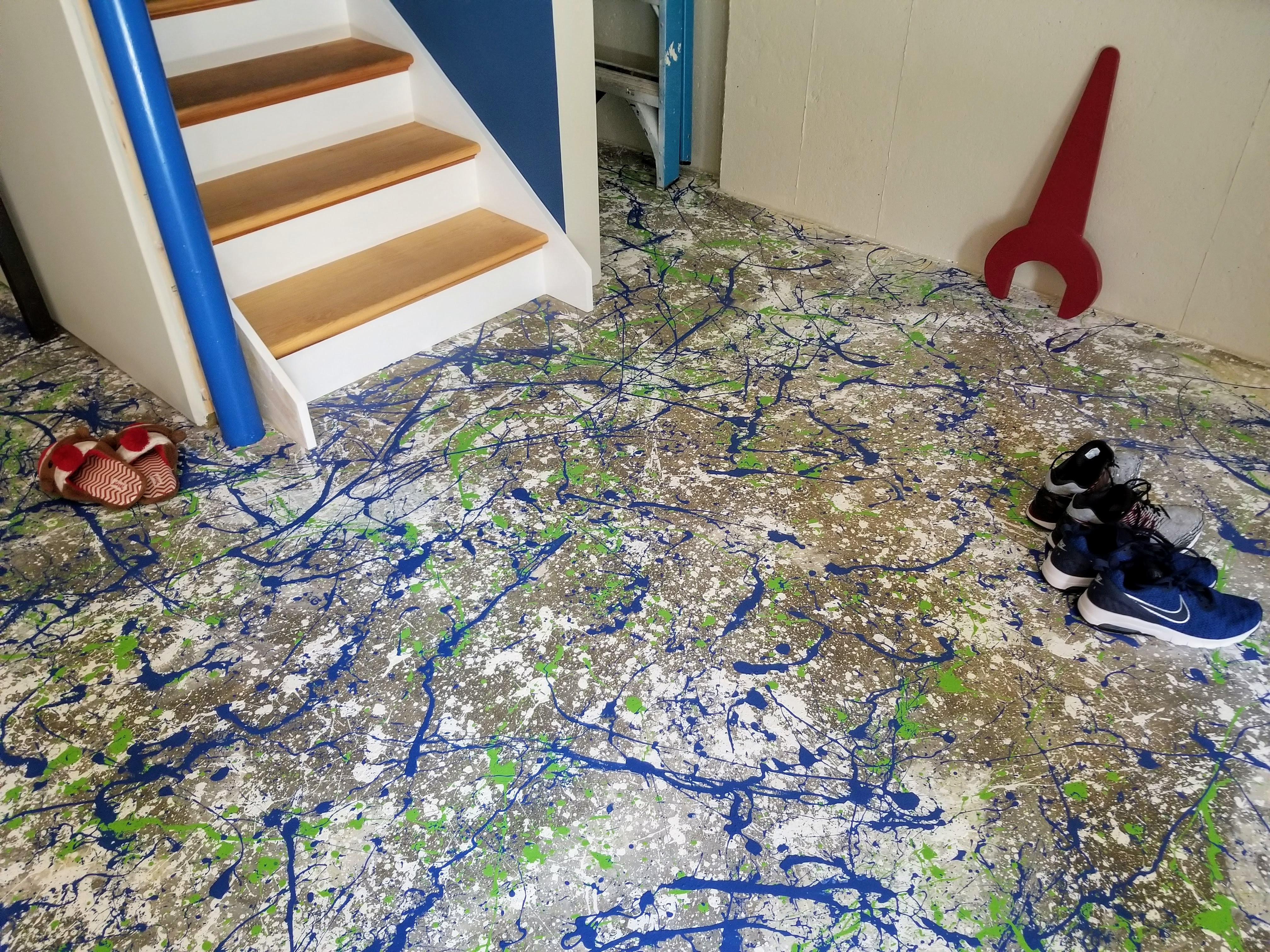
The final finish is definitely playful and whimsical, bringing a lot of life to the floor through the use of bright, bold splashes of color. With a combination of toned-down colors, I can imagine this splatter technique working even in a space that’s been more traditionally designed and decorated.
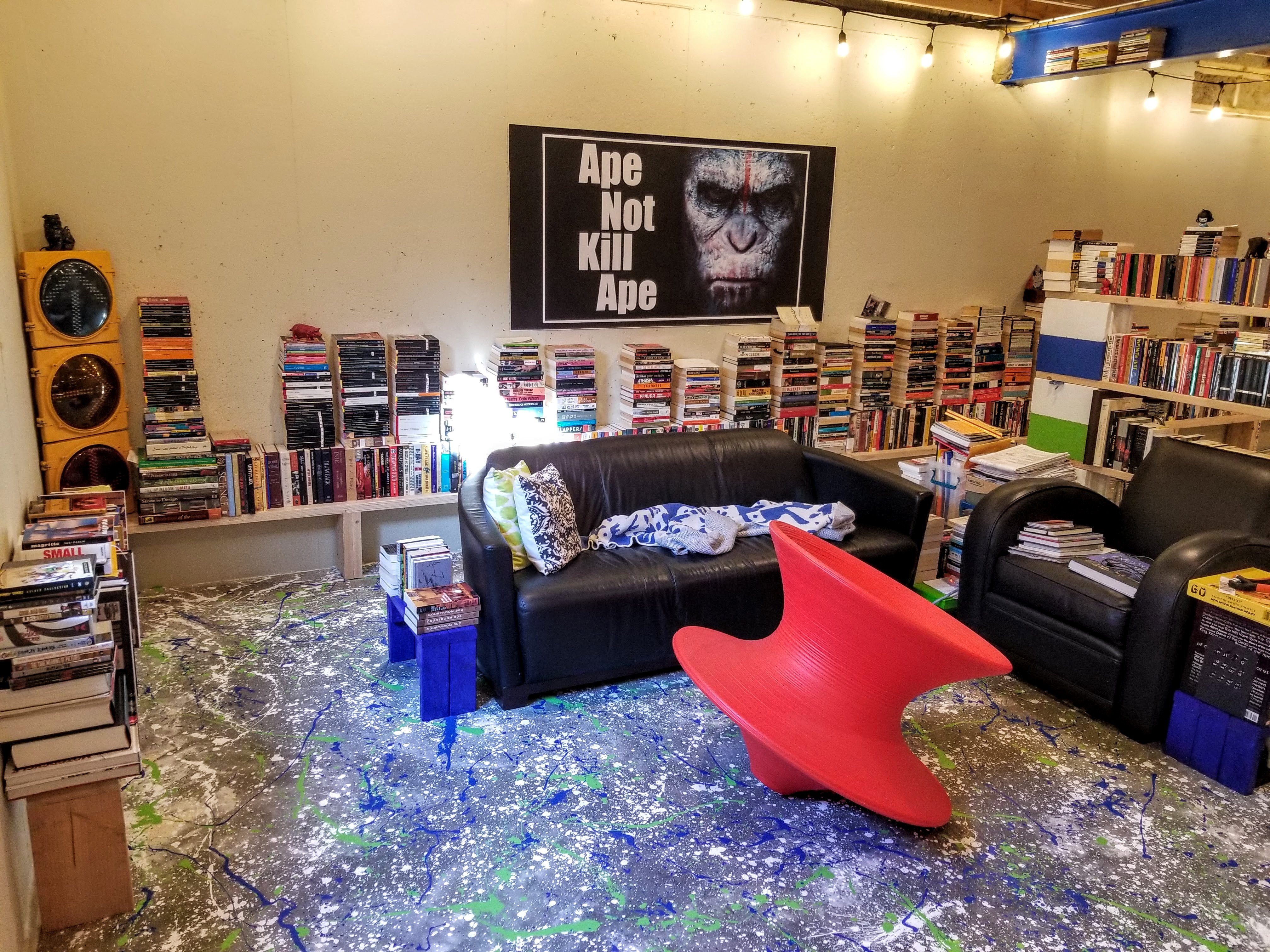
By staying neutral with the wall color, and by leaving the ceiling unfinished, it keeps the visual emphasis on the floor and the bright blue of the structural beam.
Here’s another view of the reading area:
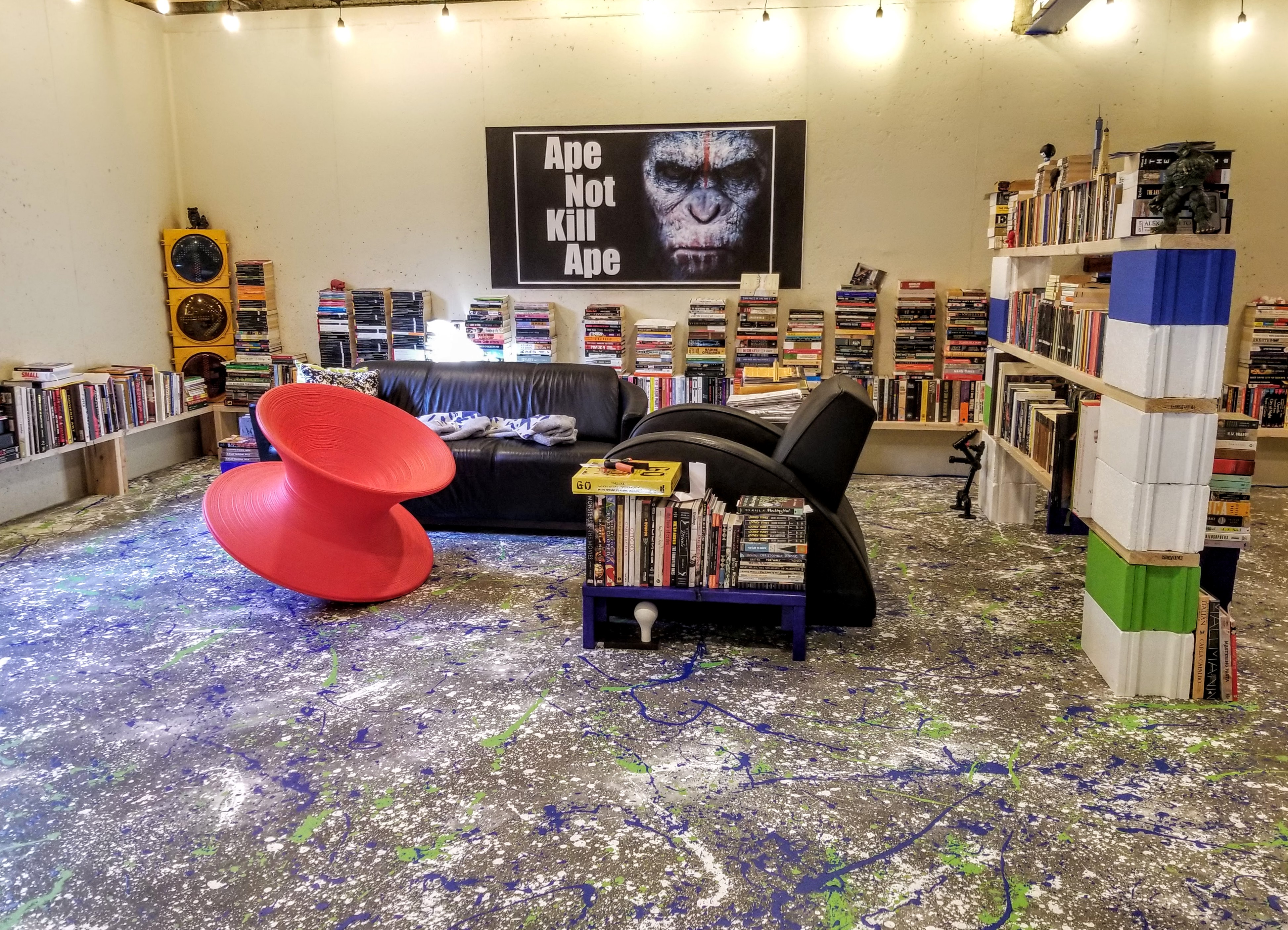
A close-up of the floor, along with the concrete lightbulb:
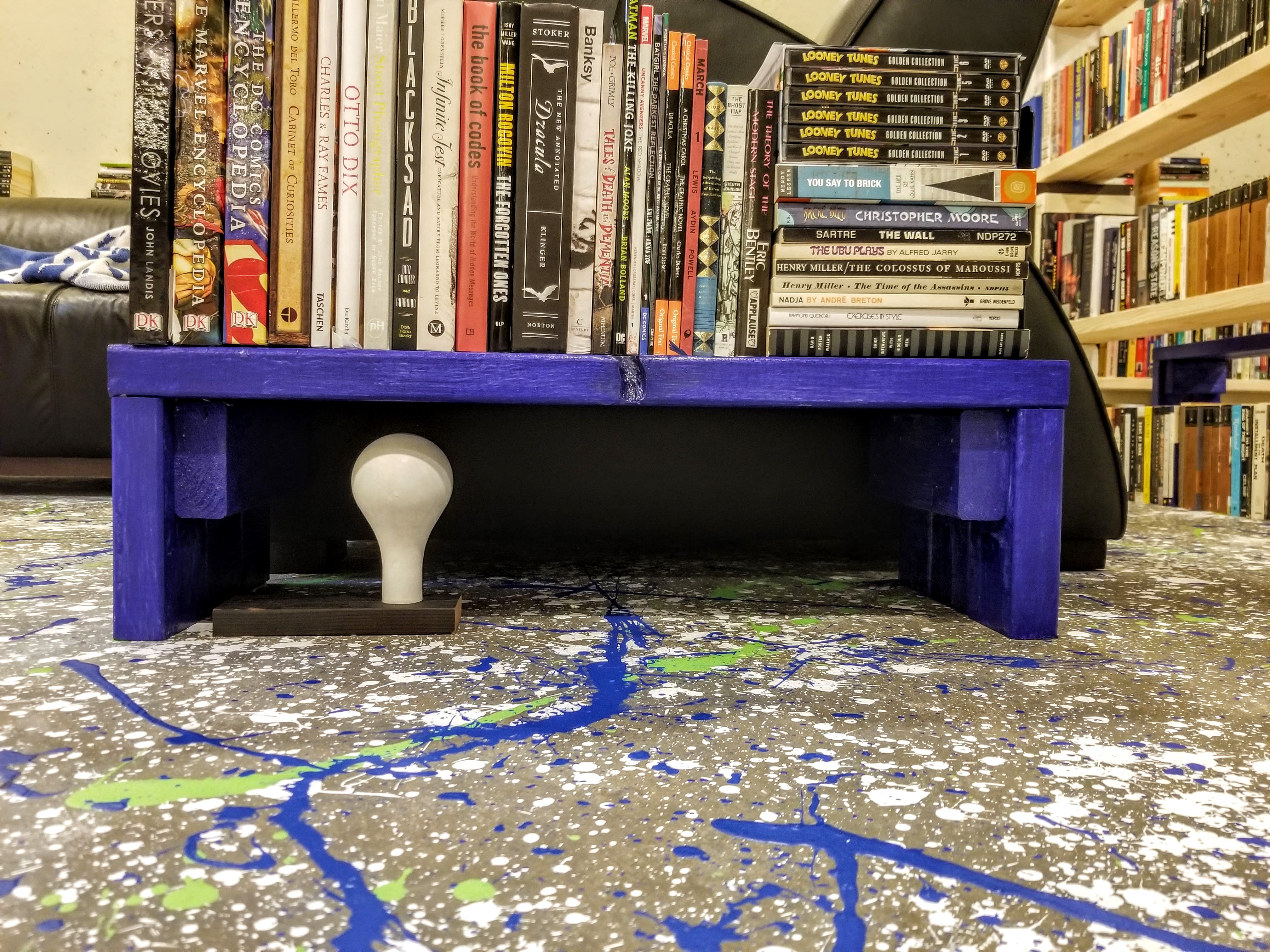
We managed to sneak in some extra storage by placing smaller books on the steel beam:
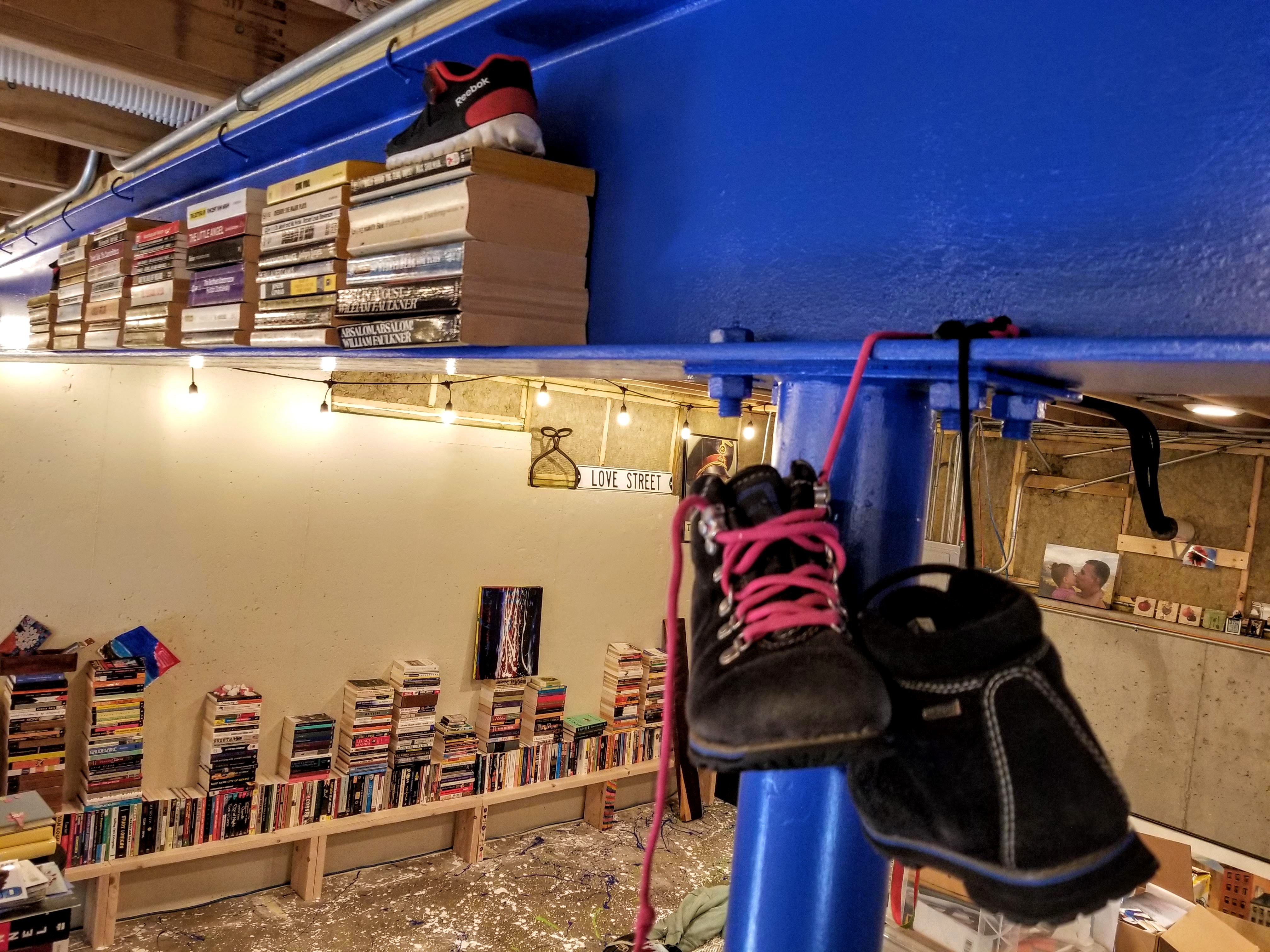
We also added pops of red accents in the basement, something we would continue on the main floor of the house:
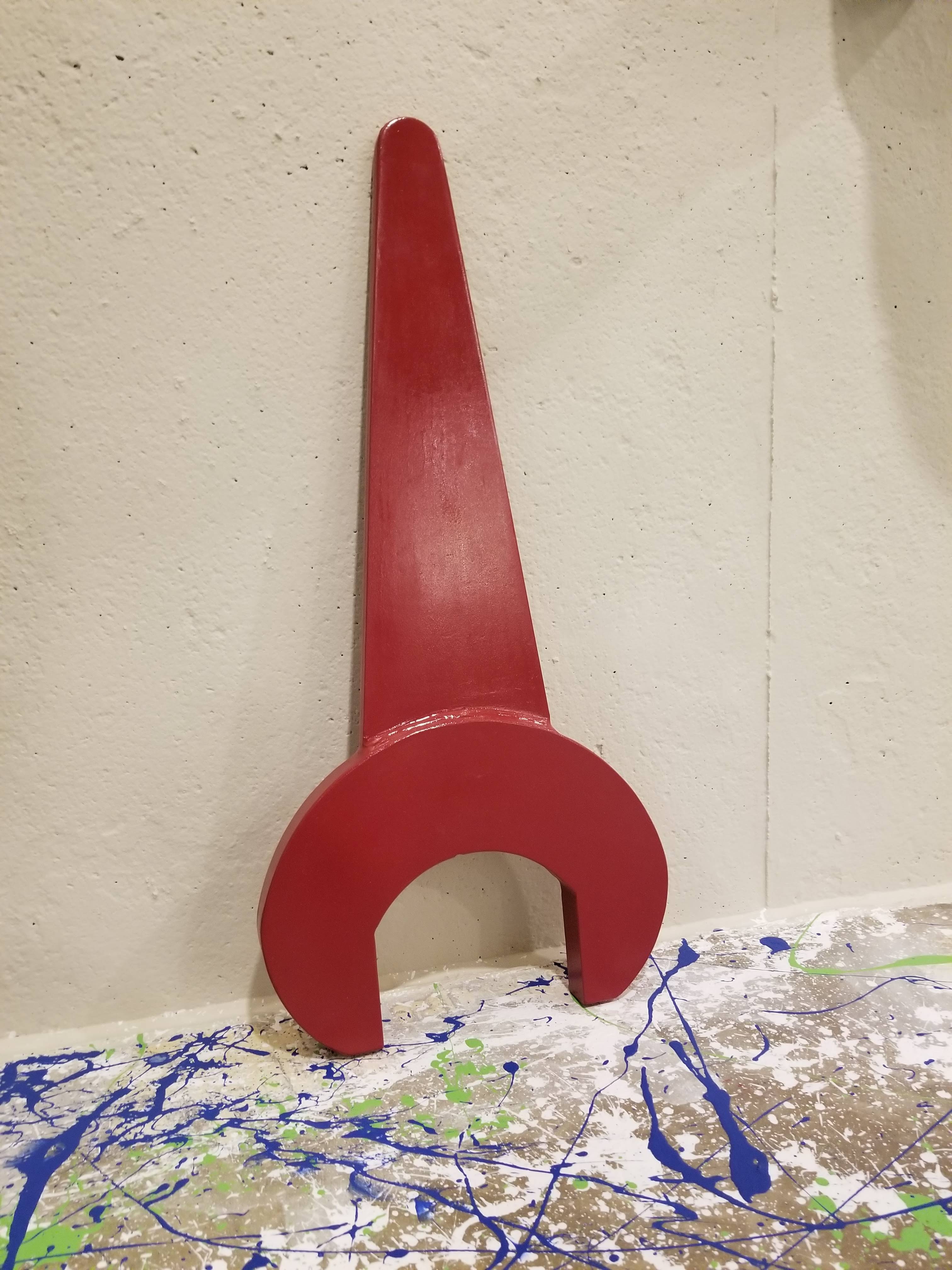
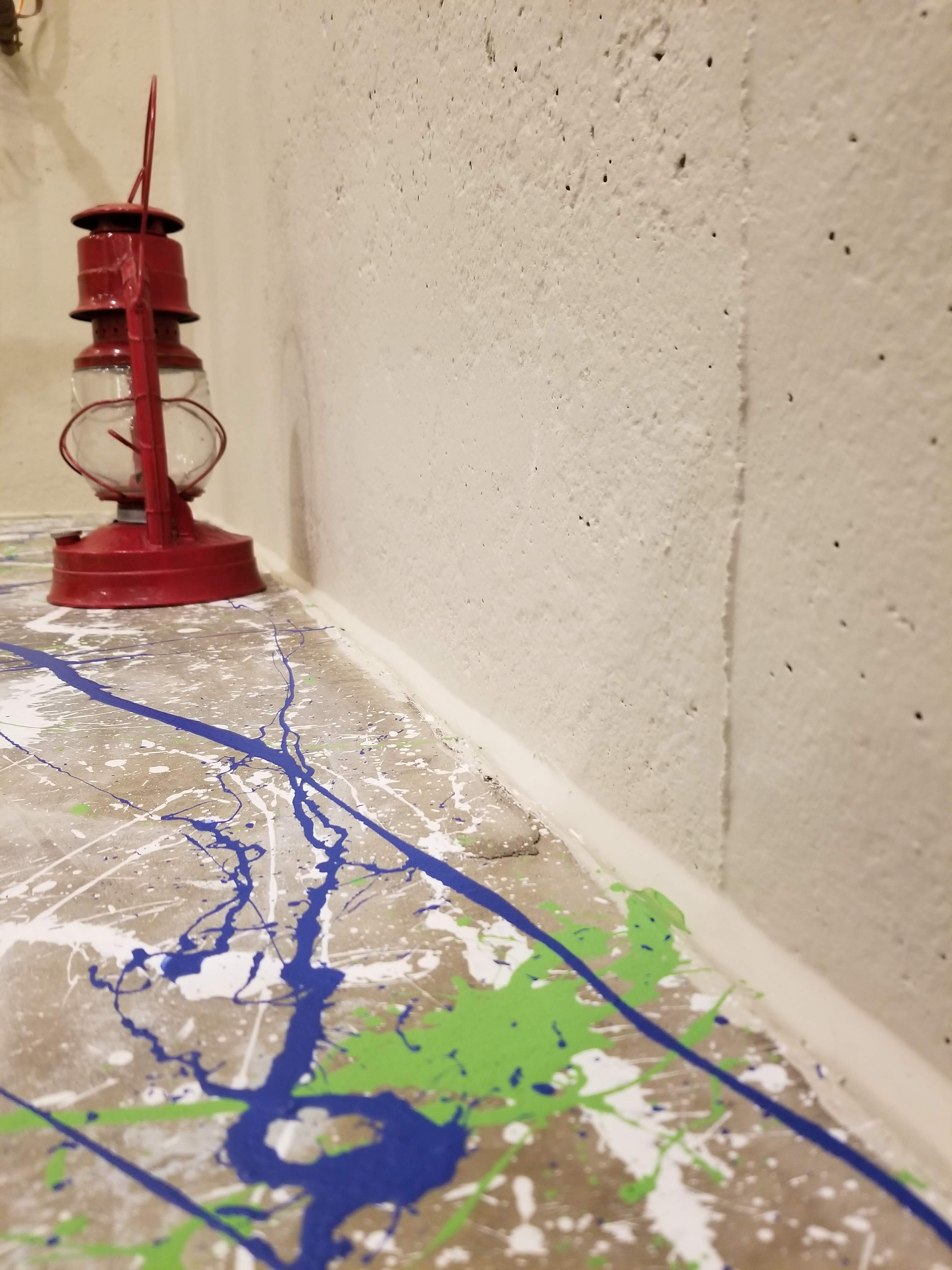
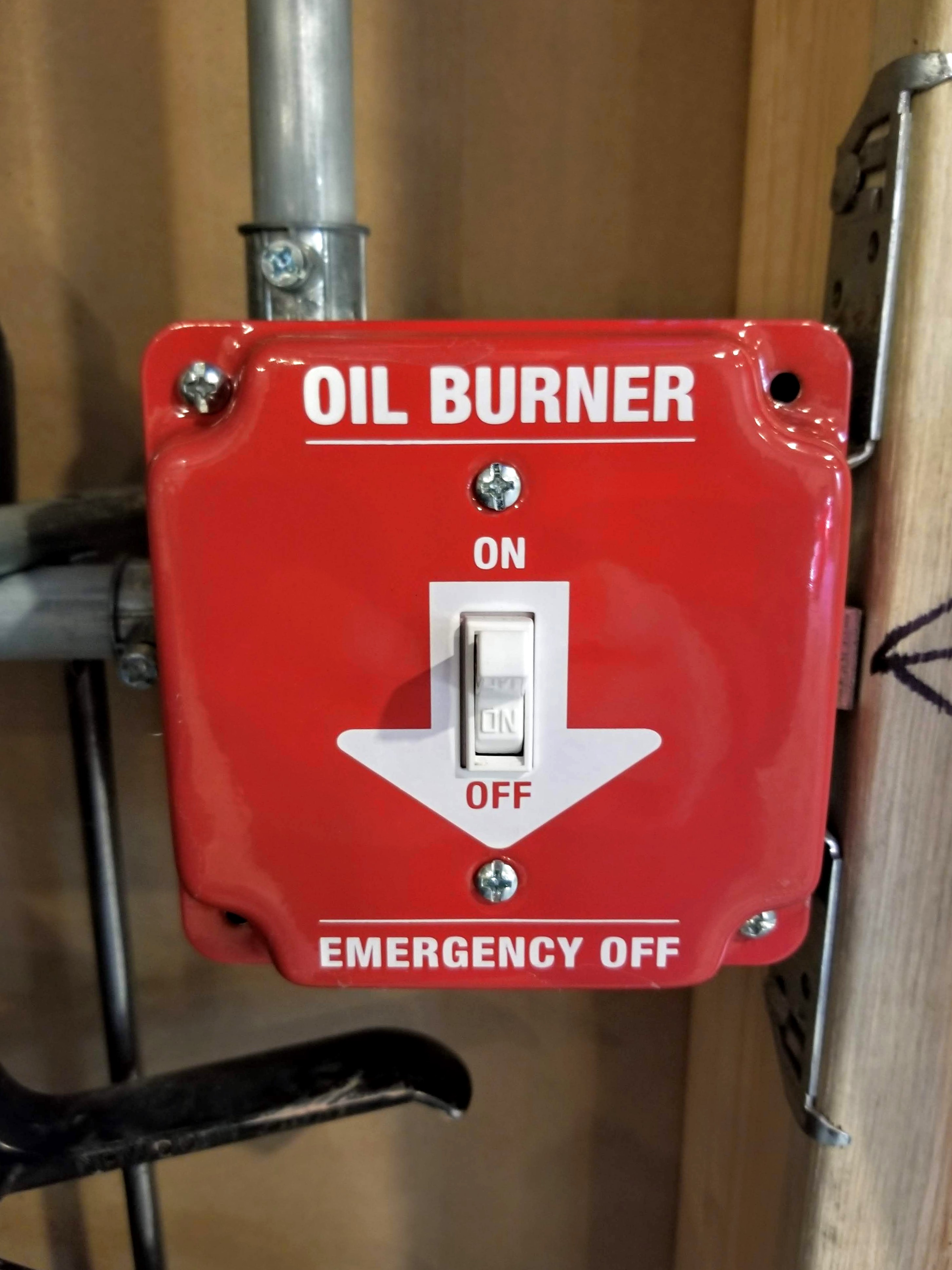
This chair was our only splurge on new furniture in the house —- an episode of Comedians in Cars Getting Coffee ended with Jerry Seinfeld and Jim Carrey enjoying a good spin:
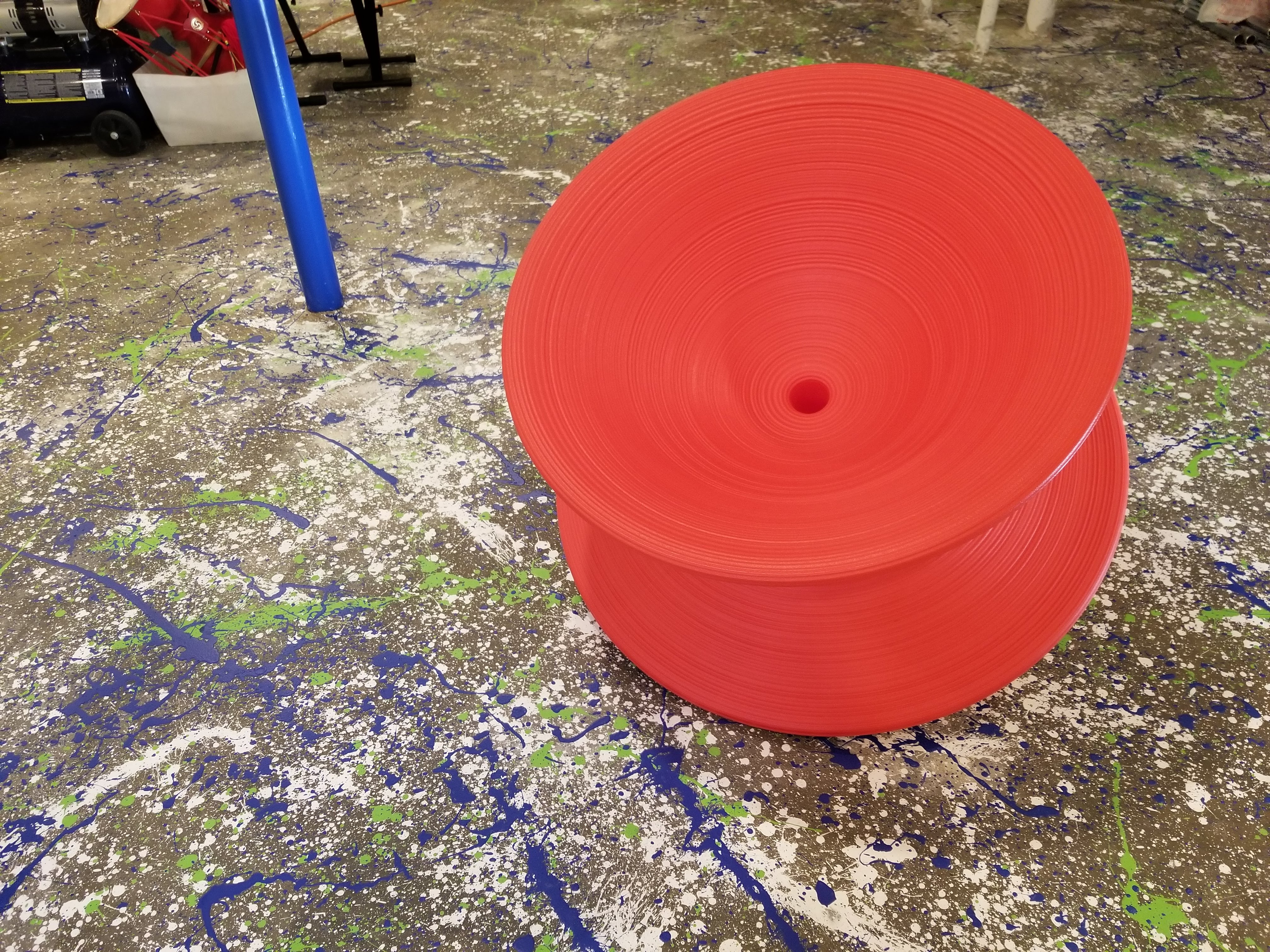
Undoubtedly, a ridiculously expensive chunk of plastic, but worth every penny if you go by the giggles-per-person of those trying it out for the first time:
A revealing test to see if your inner child is still alive and kicking.
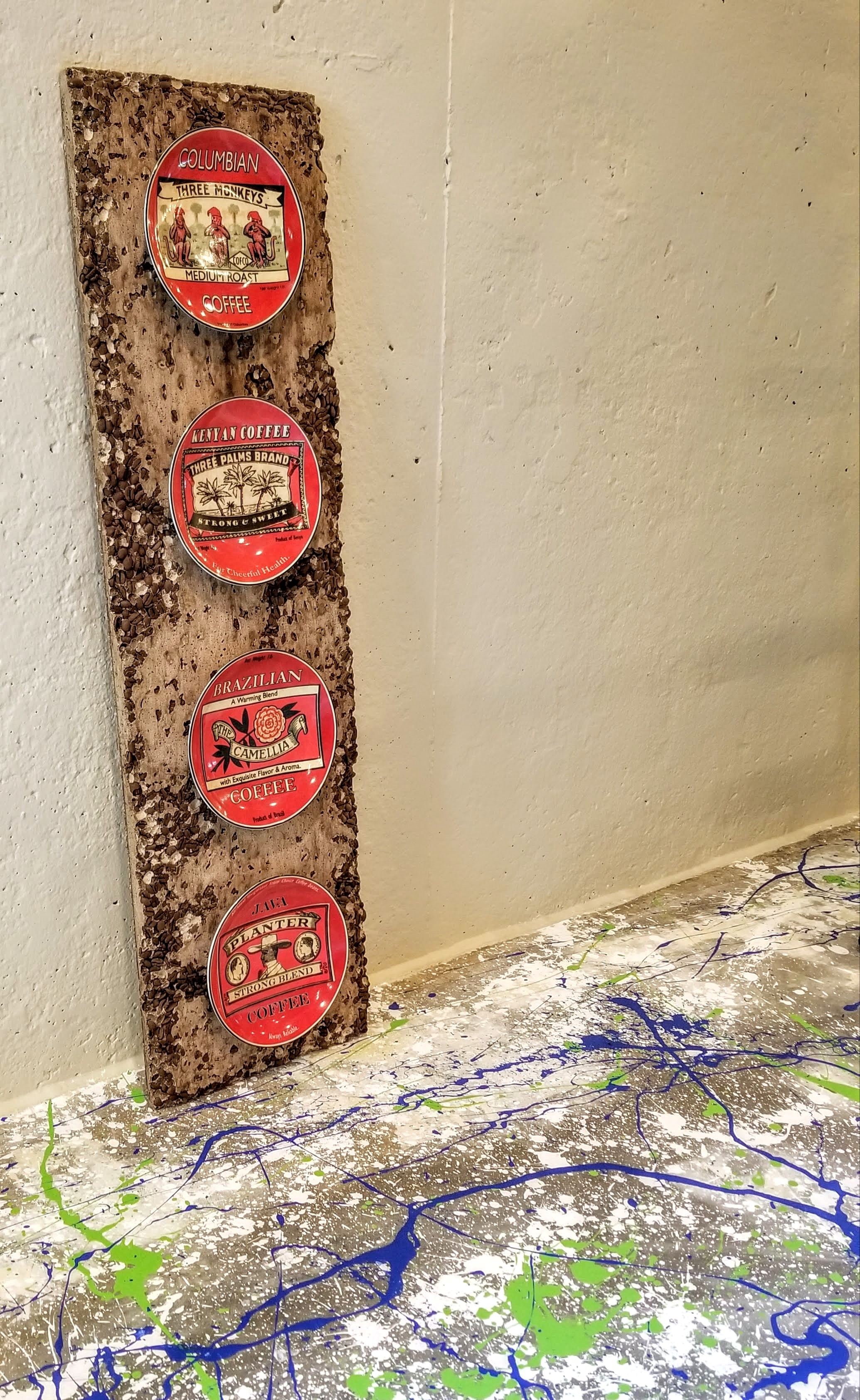
Eventually I’ll get more artwork up on the currently mostly bare concrete walls — it should really help to tie the room together:
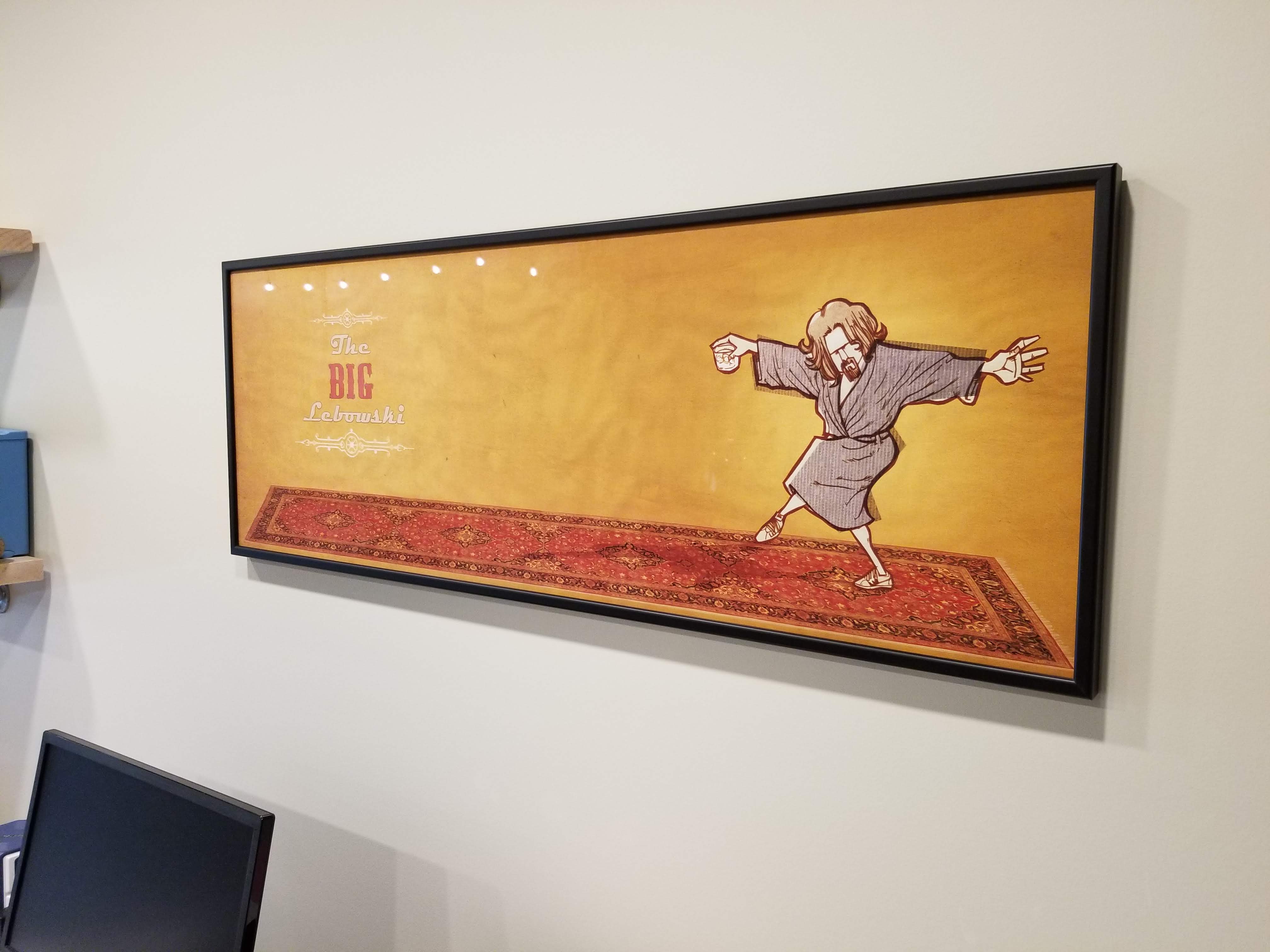
The paint splatter and tung oil finish has been in place for over a year now. It’s holding up well, even under the friction from the Spun chair wobbling around, or the office chairs and workout bench being slid across the floor.
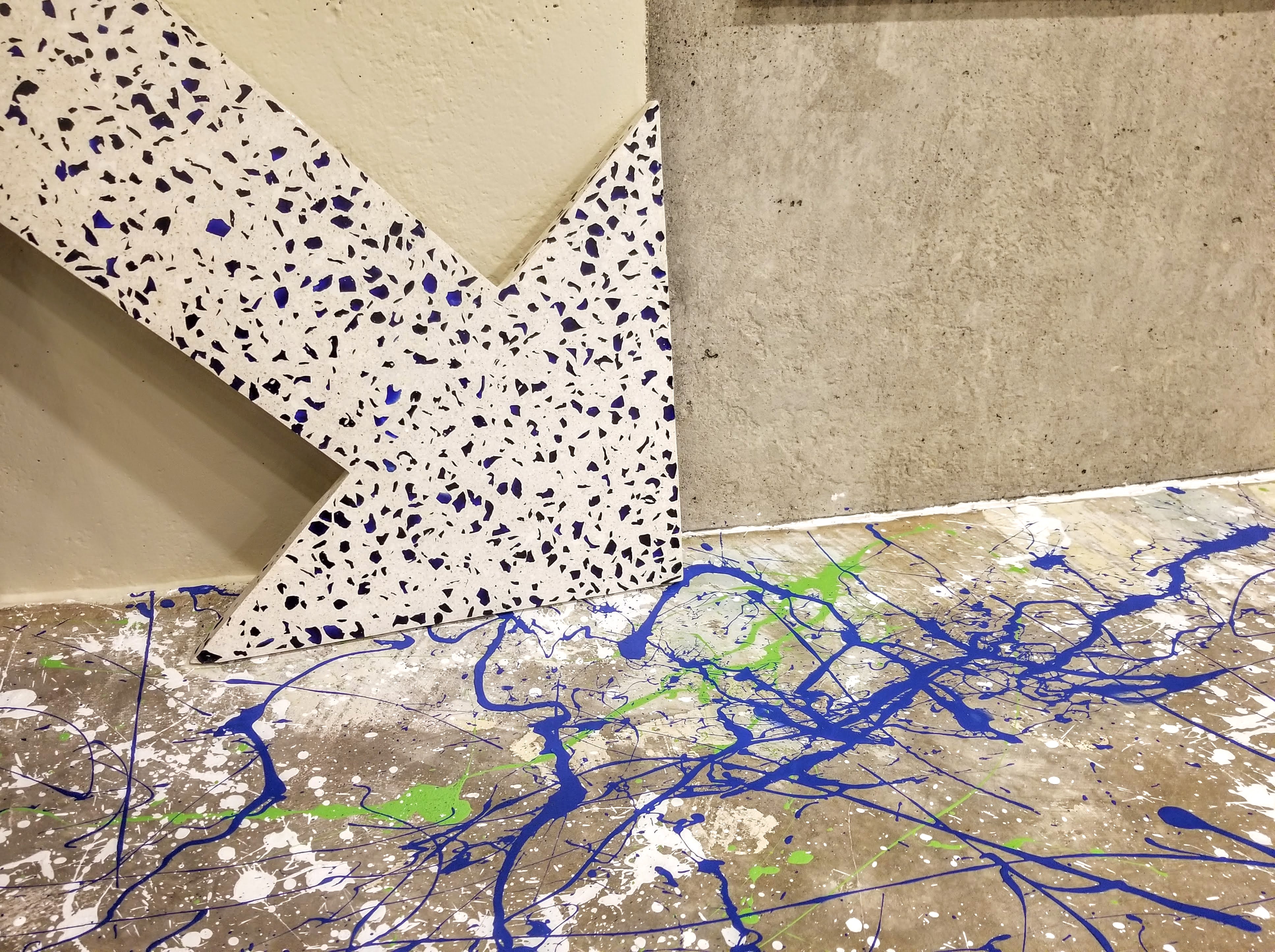
The only thing I would do differently is probably try and find a concrete sealer that’s less expensive than the tung oil and citrus solvent combination.
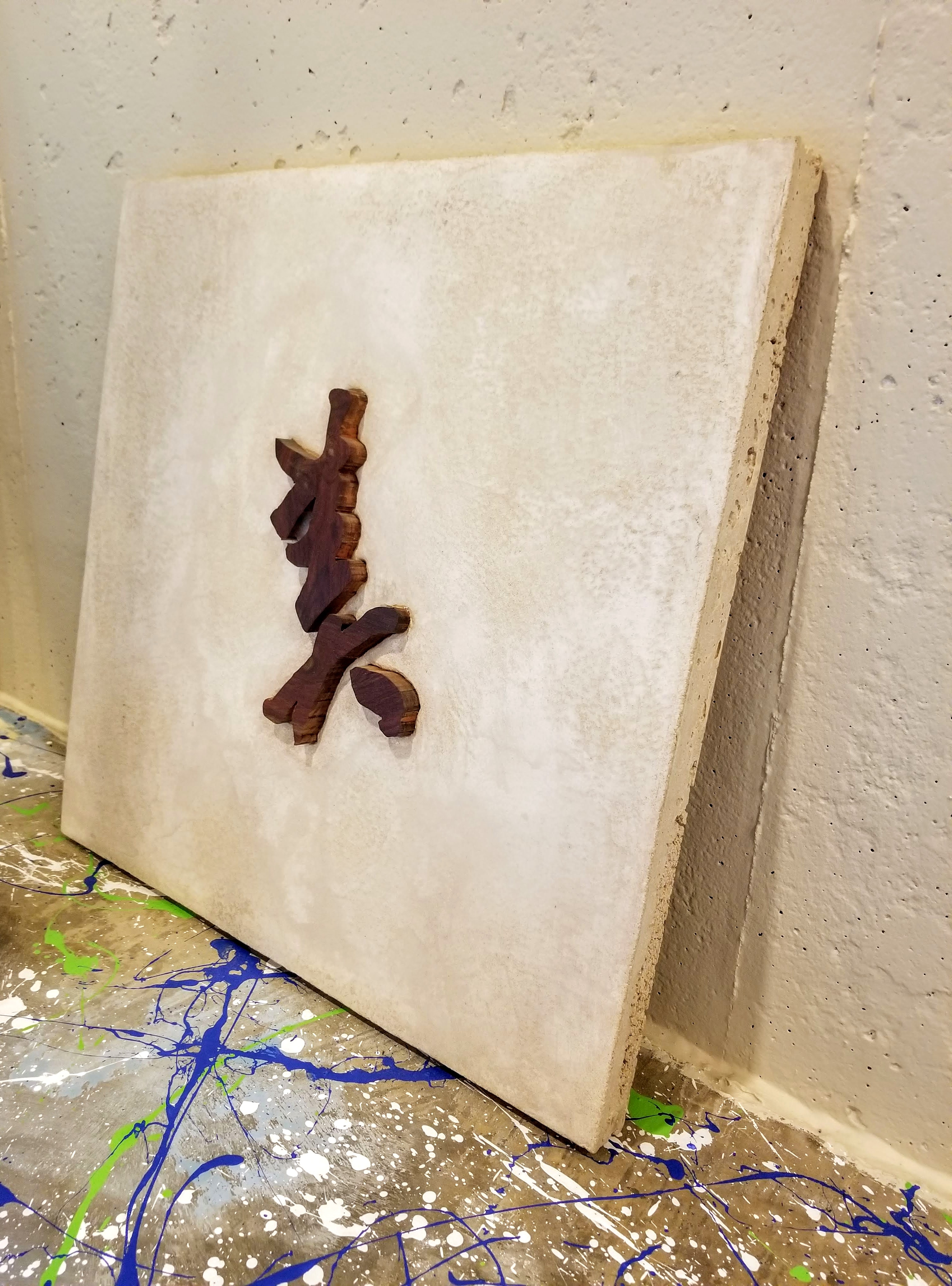
Using a different product would require testing it in a small area first for adhesion — both the sealer over the bare concrete and, once the sealer is cured, to make sure that the concrete paint fully adheres to the sealer without any issues. It would take some time to establish this definitively, but well worth the effort in order to avoid any potential issues with peeling paint.
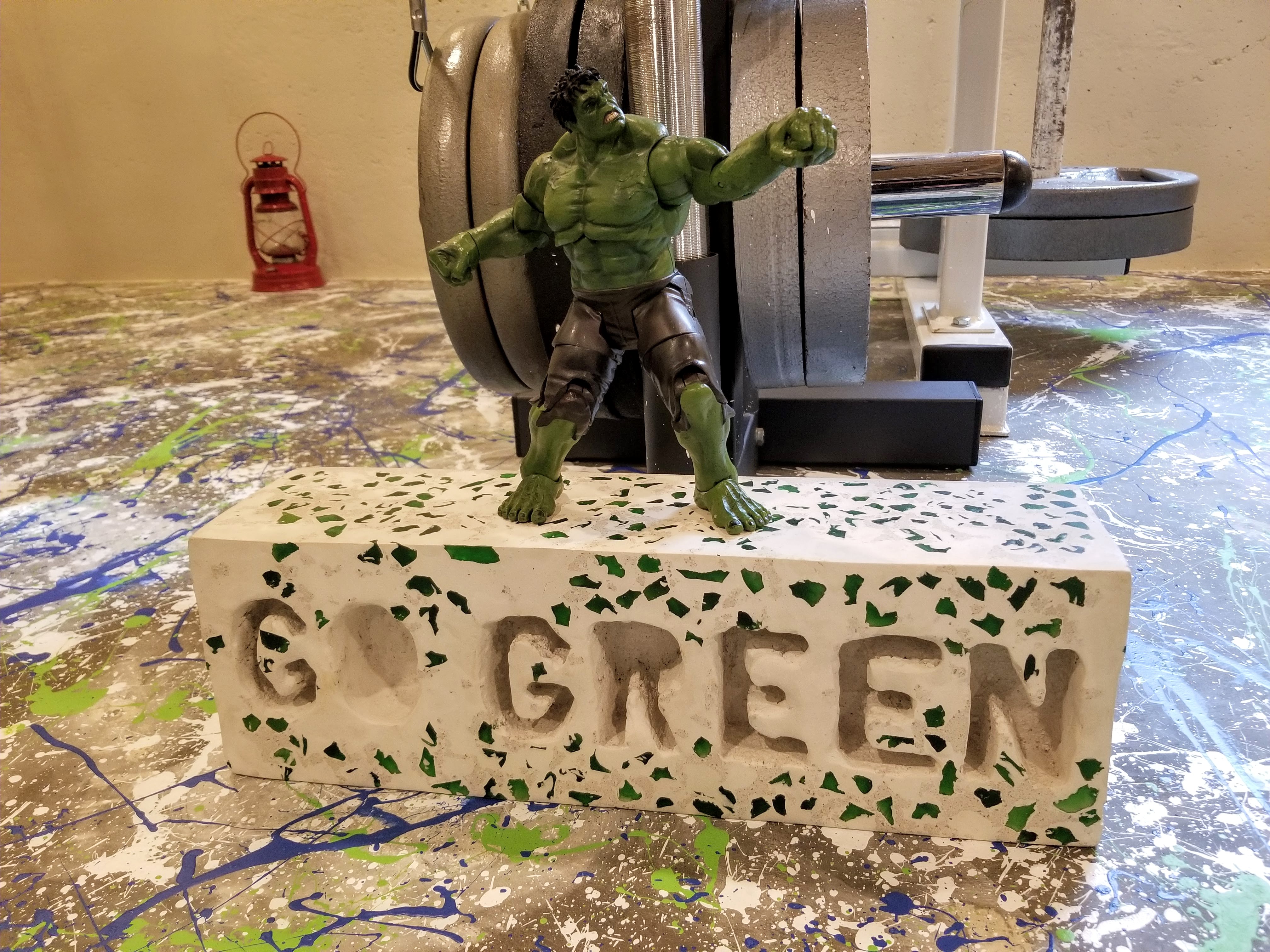
A collection of the wall art we eventually completed:
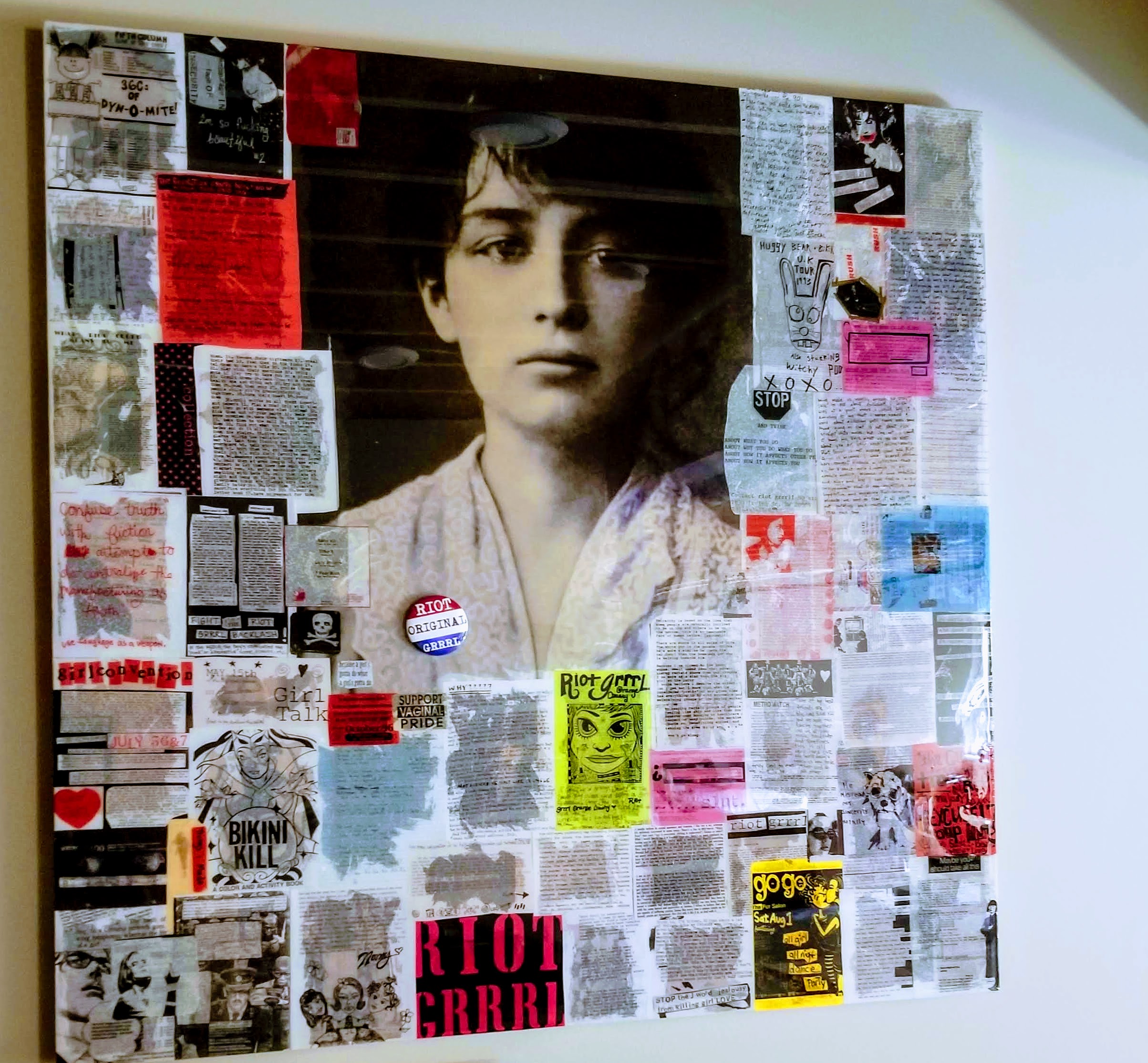
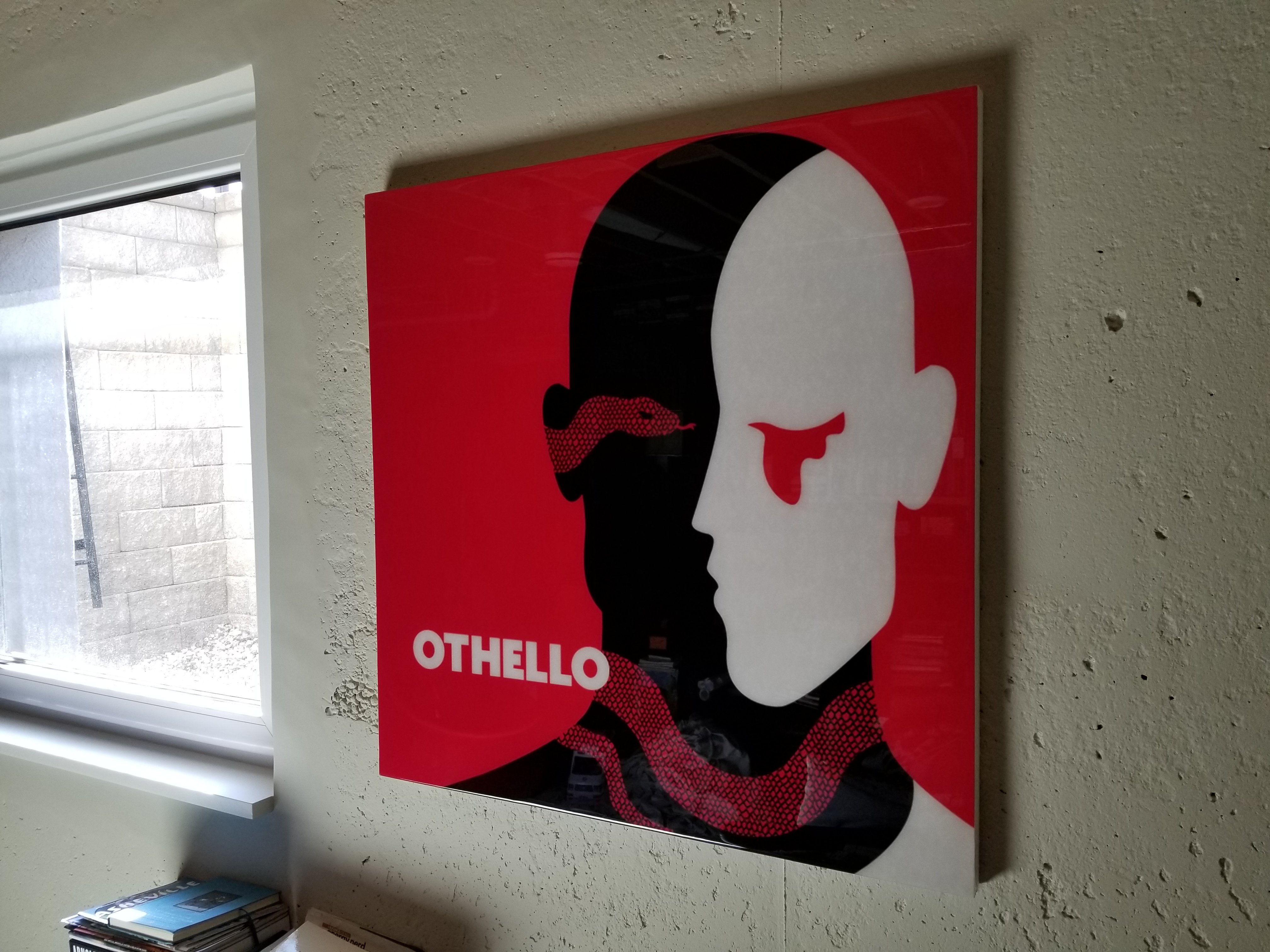
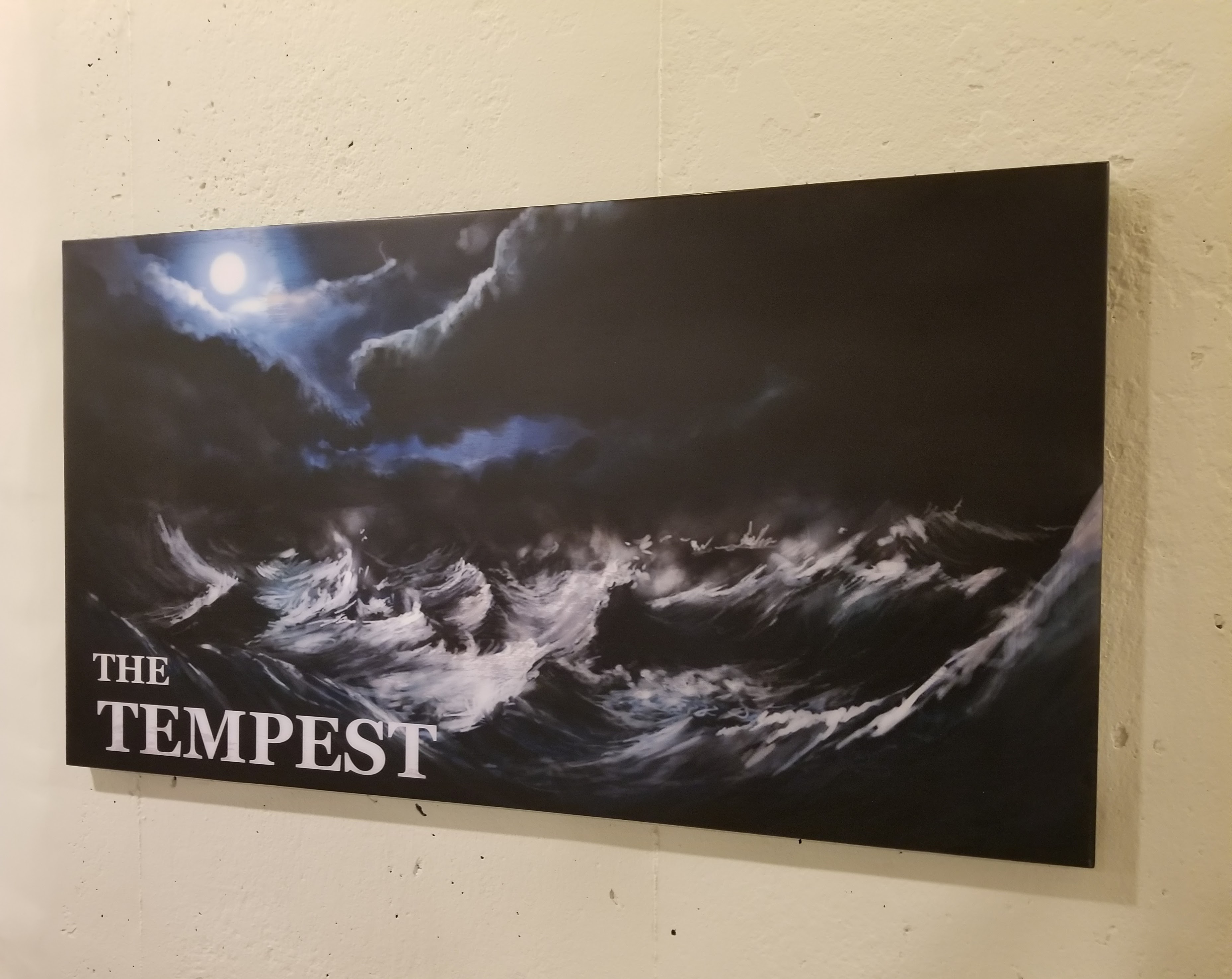

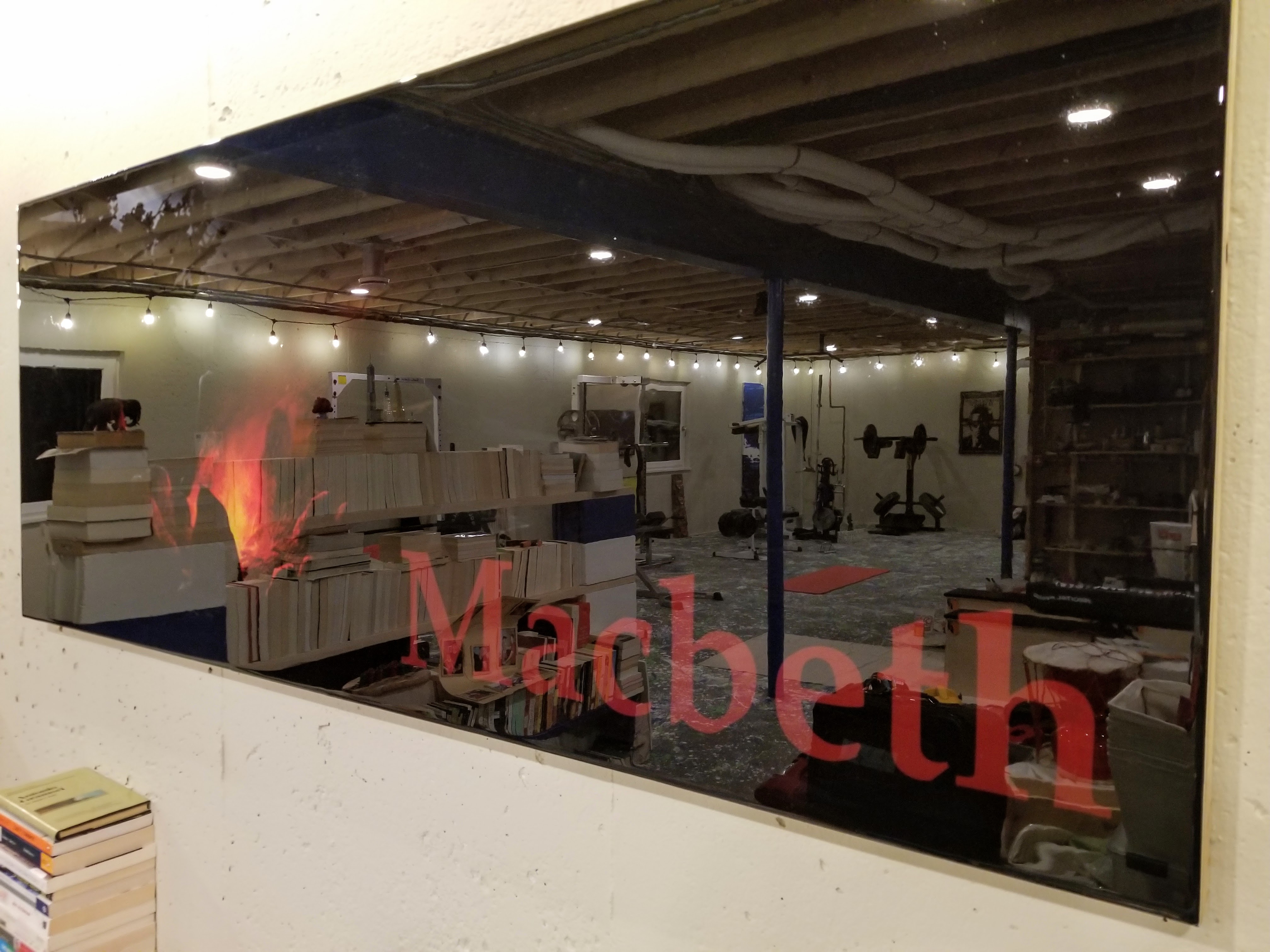
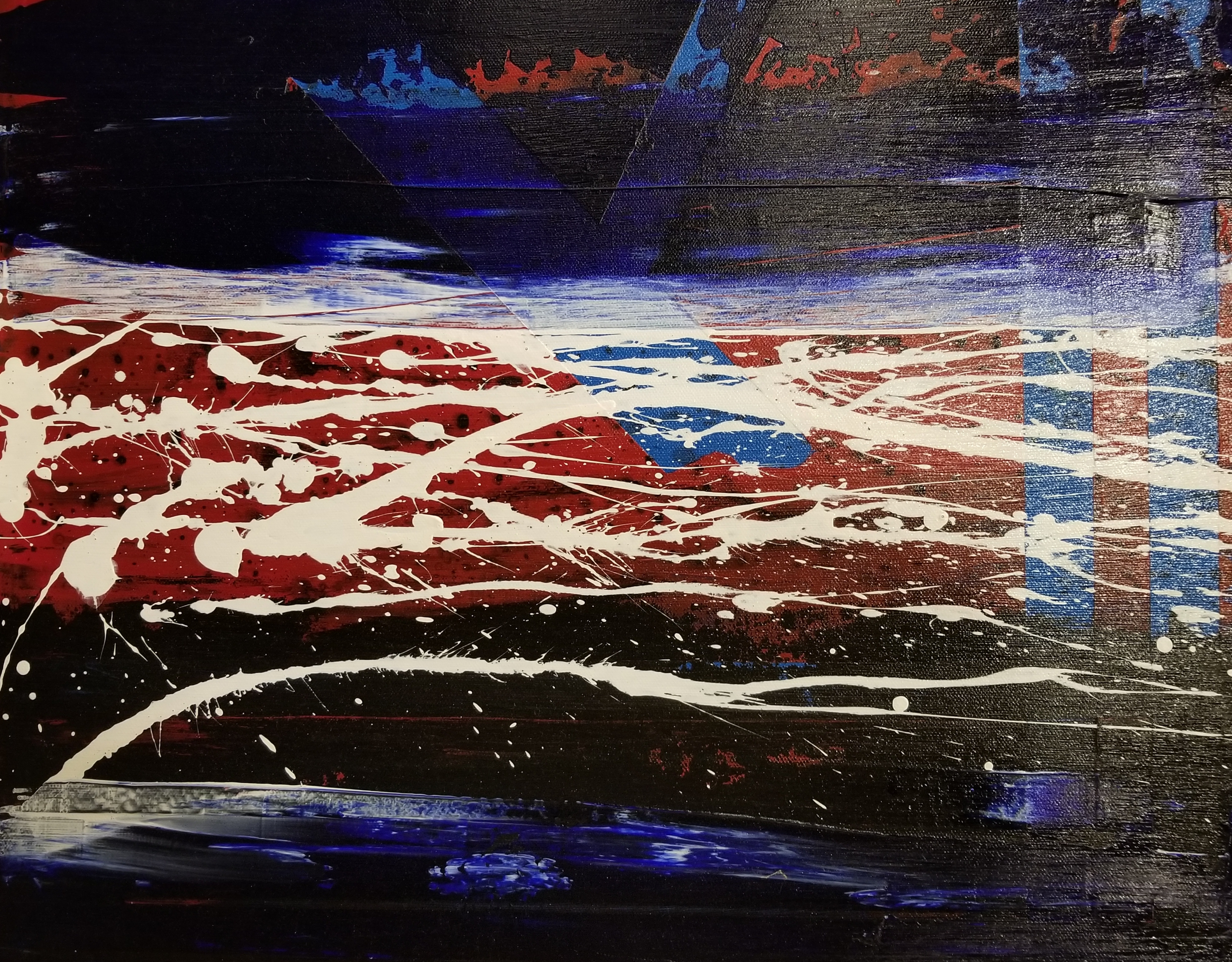
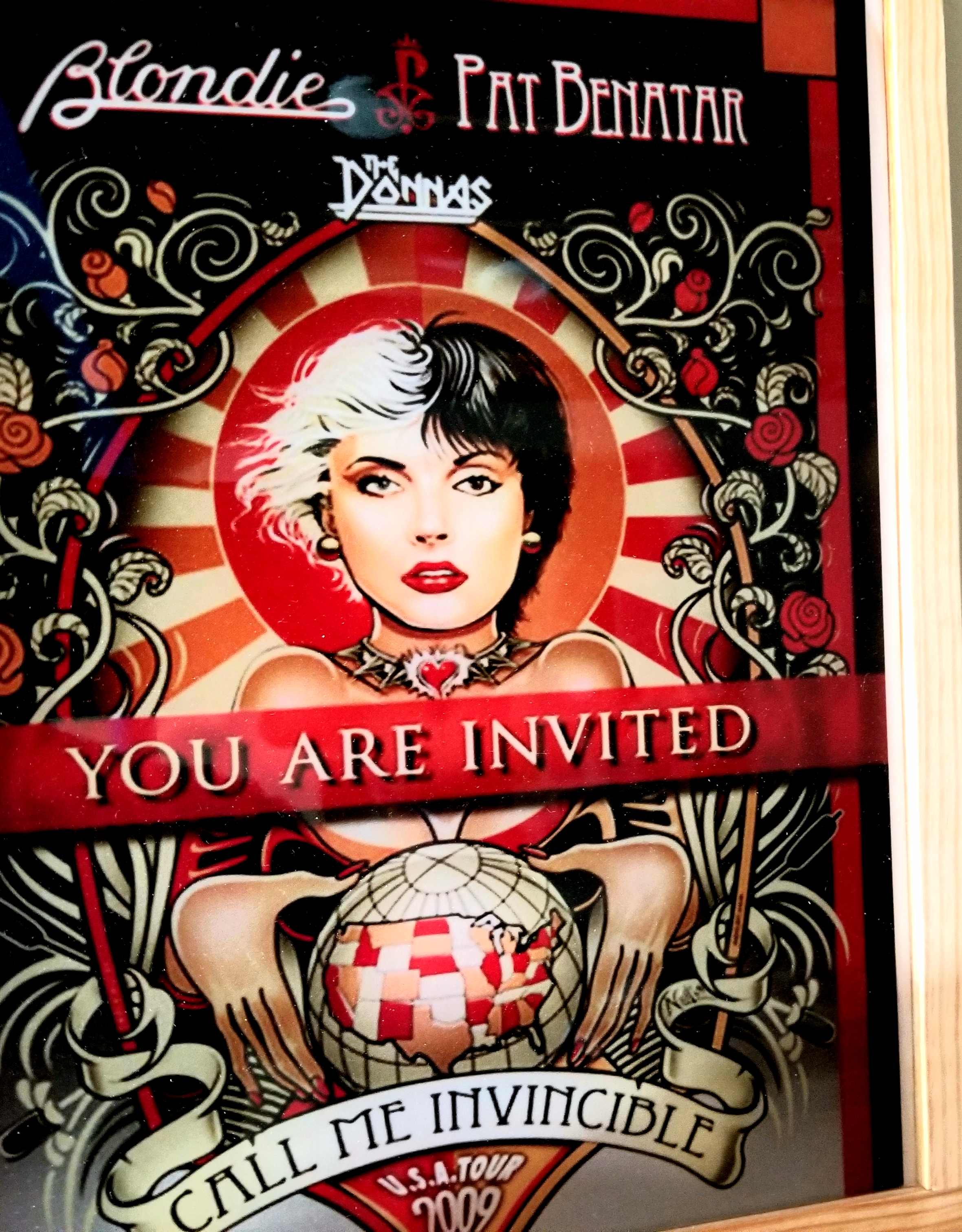
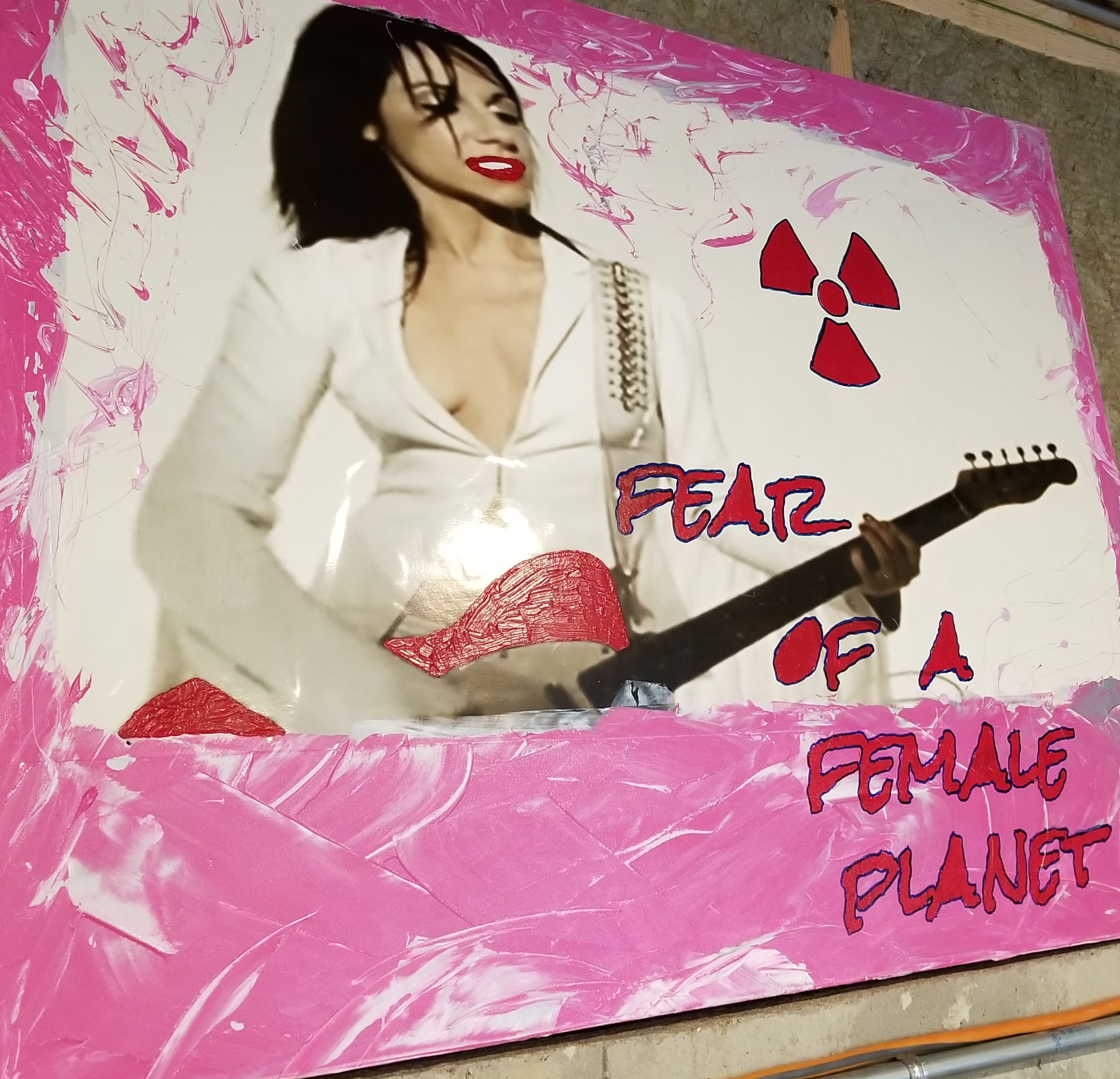
For more info on the artwork, go here:
Urban Rustic: Main Bedroom and Bath
Apart from its relatively easy application and excellent durability, we love the floor finish because it was so much fun to create. While it’s definitely not a formal looking finish, it is a project the whole family could be involved in, regardless of age or ability.
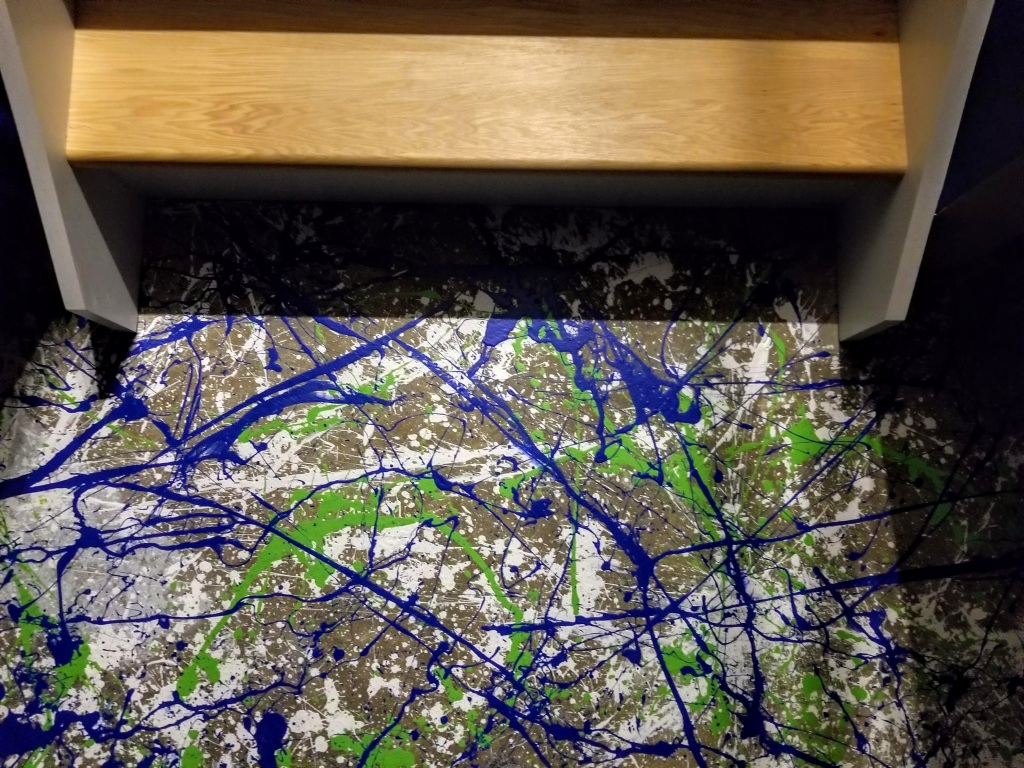
And we would gladly do it again if given the chance. We can’t recommend it enough if you’re looking for a fairly inexpensive way to finish a floor in a unique way.
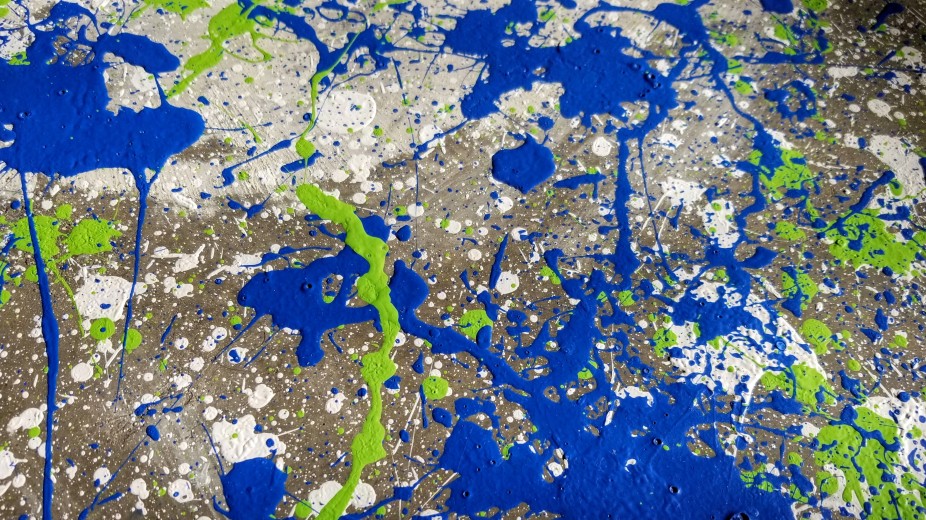
You must be logged in to post a comment.